Manage innovation and continuous improvement
VerifiedAdded on 2023/06/08
|43
|5651
|207
AI Summary
This learner workbook focuses on BSBMGT608: Manage innovation and continuous improvement. It includes instructions to the learner, assessment requirements, observation/demonstration, third party guide, and activities. The activities cover topics such as analyzing and evaluating performance, outlining stages of the supply chain, and identifying performance measures. The course code is BSBMGT608 and it is relevant for students in college or university.
Contribute Materials
Your contribution can guide someone’s learning journey. Share your
documents today.
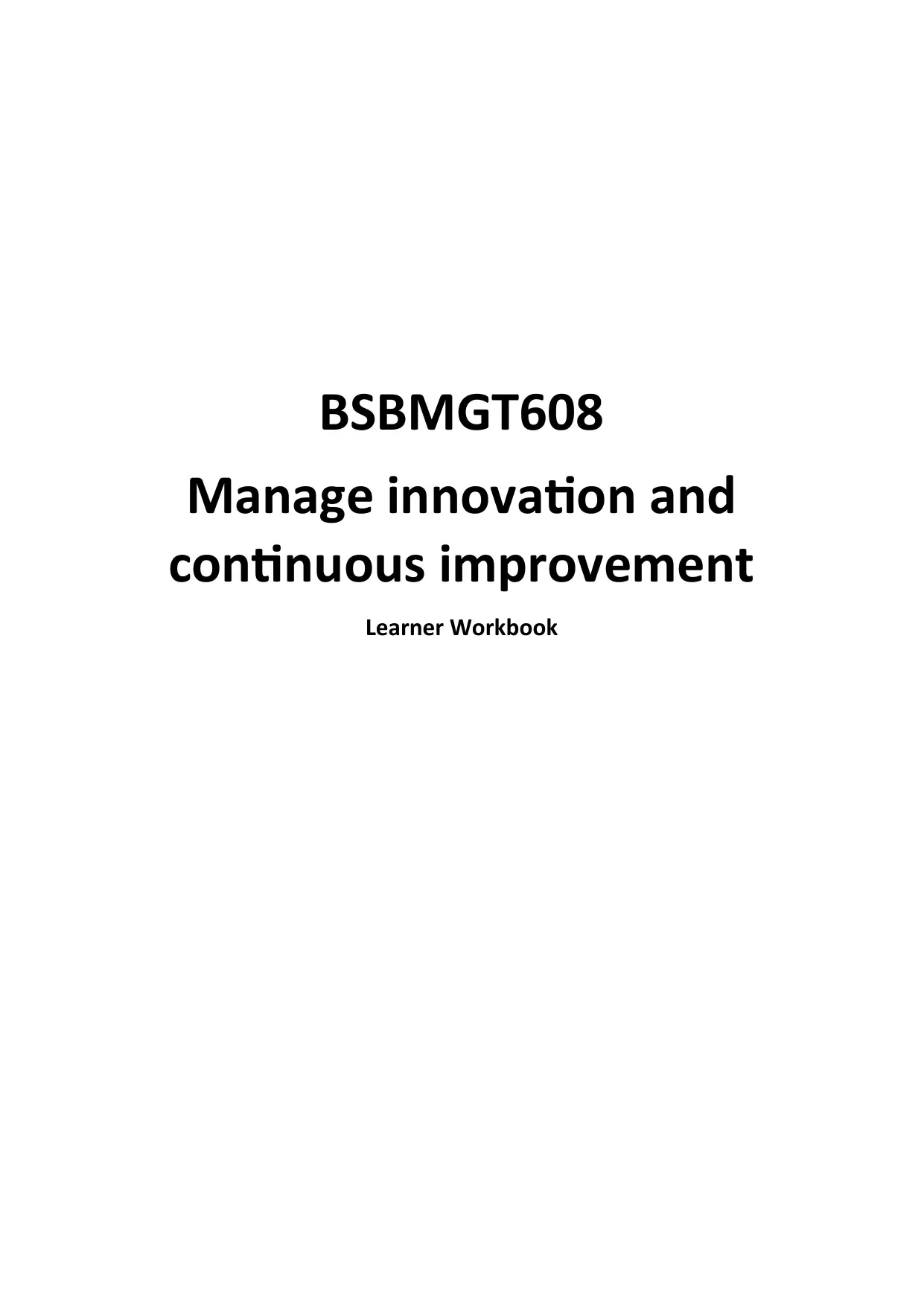
BSBMGT608
Manage innovation and
continuous improvement
Learner Workbook
Manage innovation and
continuous improvement
Learner Workbook
Secure Best Marks with AI Grader
Need help grading? Try our AI Grader for instant feedback on your assignments.
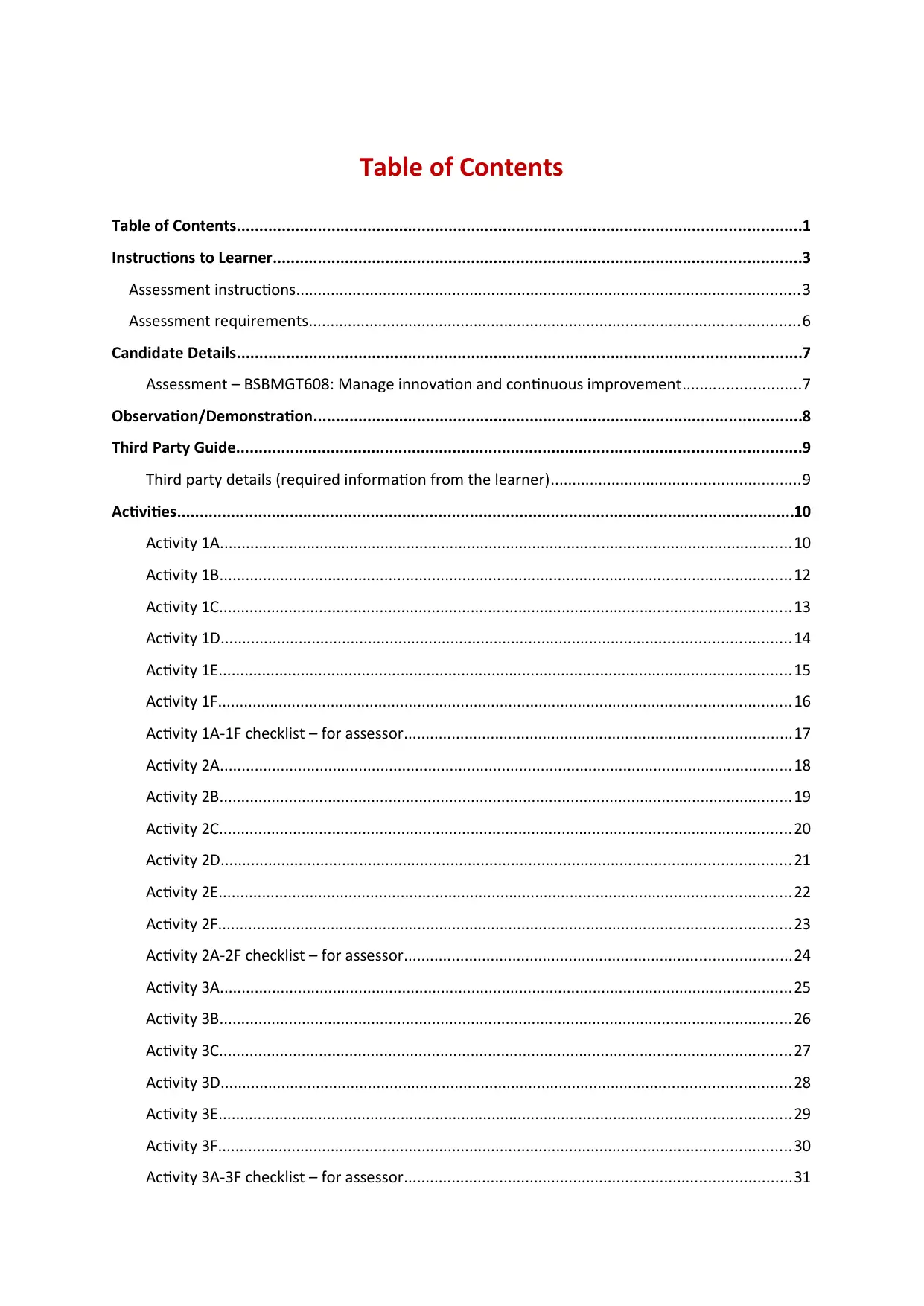
Table of Contents
Table of Contents.............................................................................................................................1
Instructions to Learner.....................................................................................................................3
Assessment instructions....................................................................................................................3
Assessment requirements.................................................................................................................6
Candidate Details.............................................................................................................................7
Assessment – BSBMGT608: Manage innovation and continuous improvement...........................7
Observation/Demonstration............................................................................................................8
Third Party Guide.............................................................................................................................9
Third party details (required information from the learner).........................................................9
Activities.........................................................................................................................................10
Activity 1A....................................................................................................................................10
Activity 1B....................................................................................................................................12
Activity 1C....................................................................................................................................13
Activity 1D...................................................................................................................................14
Activity 1E....................................................................................................................................15
Activity 1F....................................................................................................................................16
Activity 1A-1F checklist – for assessor.........................................................................................17
Activity 2A....................................................................................................................................18
Activity 2B....................................................................................................................................19
Activity 2C....................................................................................................................................20
Activity 2D...................................................................................................................................21
Activity 2E....................................................................................................................................22
Activity 2F....................................................................................................................................23
Activity 2A-2F checklist – for assessor.........................................................................................24
Activity 3A....................................................................................................................................25
Activity 3B....................................................................................................................................26
Activity 3C....................................................................................................................................27
Activity 3D...................................................................................................................................28
Activity 3E....................................................................................................................................29
Activity 3F....................................................................................................................................30
Activity 3A-3F checklist – for assessor.........................................................................................31
Table of Contents.............................................................................................................................1
Instructions to Learner.....................................................................................................................3
Assessment instructions....................................................................................................................3
Assessment requirements.................................................................................................................6
Candidate Details.............................................................................................................................7
Assessment – BSBMGT608: Manage innovation and continuous improvement...........................7
Observation/Demonstration............................................................................................................8
Third Party Guide.............................................................................................................................9
Third party details (required information from the learner).........................................................9
Activities.........................................................................................................................................10
Activity 1A....................................................................................................................................10
Activity 1B....................................................................................................................................12
Activity 1C....................................................................................................................................13
Activity 1D...................................................................................................................................14
Activity 1E....................................................................................................................................15
Activity 1F....................................................................................................................................16
Activity 1A-1F checklist – for assessor.........................................................................................17
Activity 2A....................................................................................................................................18
Activity 2B....................................................................................................................................19
Activity 2C....................................................................................................................................20
Activity 2D...................................................................................................................................21
Activity 2E....................................................................................................................................22
Activity 2F....................................................................................................................................23
Activity 2A-2F checklist – for assessor.........................................................................................24
Activity 3A....................................................................................................................................25
Activity 3B....................................................................................................................................26
Activity 3C....................................................................................................................................27
Activity 3D...................................................................................................................................28
Activity 3E....................................................................................................................................29
Activity 3F....................................................................................................................................30
Activity 3A-3F checklist – for assessor.........................................................................................31
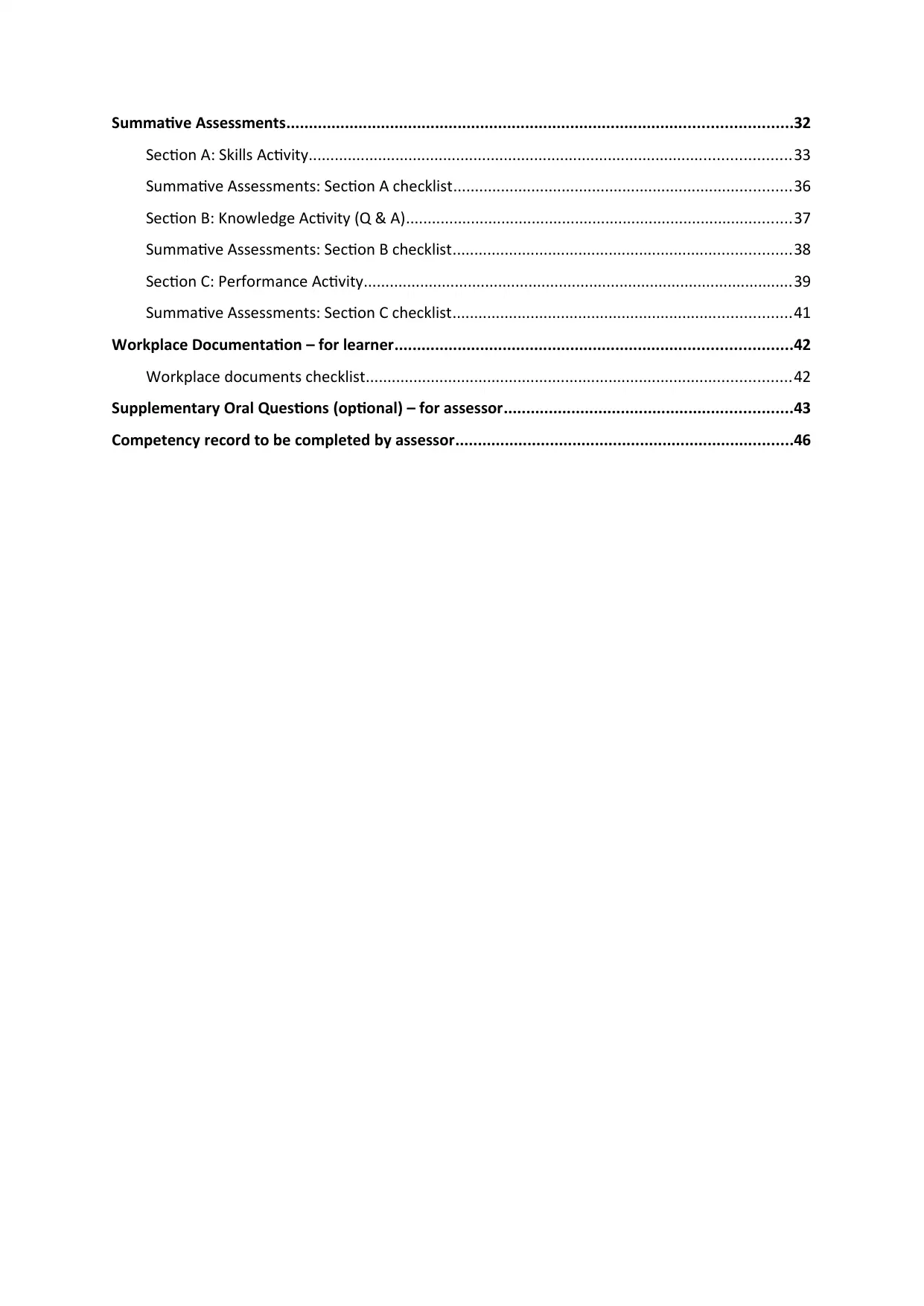
Summative Assessments................................................................................................................32
Section A: Skills Activity...............................................................................................................33
Summative Assessments: Section A checklist..............................................................................36
Section B: Knowledge Activity (Q & A).........................................................................................37
Summative Assessments: Section B checklist..............................................................................38
Section C: Performance Activity...................................................................................................39
Summative Assessments: Section C checklist..............................................................................41
Workplace Documentation – for learner........................................................................................42
Workplace documents checklist..................................................................................................42
Supplementary Oral Questions (optional) – for assessor................................................................43
Competency record to be completed by assessor...........................................................................46
Section A: Skills Activity...............................................................................................................33
Summative Assessments: Section A checklist..............................................................................36
Section B: Knowledge Activity (Q & A).........................................................................................37
Summative Assessments: Section B checklist..............................................................................38
Section C: Performance Activity...................................................................................................39
Summative Assessments: Section C checklist..............................................................................41
Workplace Documentation – for learner........................................................................................42
Workplace documents checklist..................................................................................................42
Supplementary Oral Questions (optional) – for assessor................................................................43
Competency record to be completed by assessor...........................................................................46
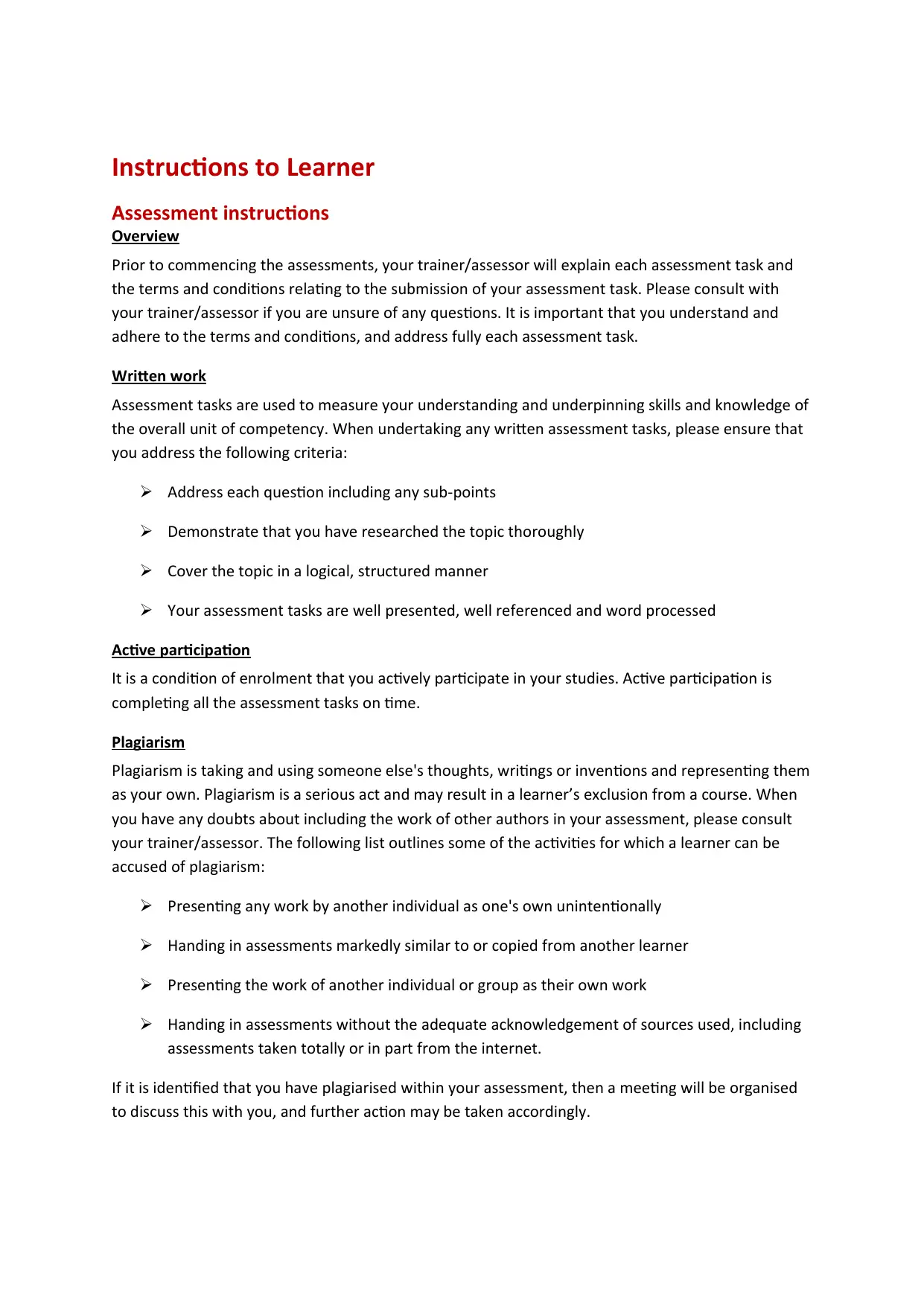
Instructions to Learner
Assessment instructions
Overview
Prior to commencing the assessments, your trainer/assessor will explain each assessment task and
the terms and conditions relating to the submission of your assessment task. Please consult with
your trainer/assessor if you are unsure of any questions. It is important that you understand and
adhere to the terms and conditions, and address fully each assessment task.
Written work
Assessment tasks are used to measure your understanding and underpinning skills and knowledge of
the overall unit of competency. When undertaking any written assessment tasks, please ensure that
you address the following criteria:
Address each question including any sub-points
Demonstrate that you have researched the topic thoroughly
Cover the topic in a logical, structured manner
Your assessment tasks are well presented, well referenced and word processed
Active participation
It is a condition of enrolment that you actively participate in your studies. Active participation is
completing all the assessment tasks on time.
Plagiarism
Plagiarism is taking and using someone else's thoughts, writings or inventions and representing them
as your own. Plagiarism is a serious act and may result in a learner’s exclusion from a course. When
you have any doubts about including the work of other authors in your assessment, please consult
your trainer/assessor. The following list outlines some of the activities for which a learner can be
accused of plagiarism:
Presenting any work by another individual as one's own unintentionally
Handing in assessments markedly similar to or copied from another learner
Presenting the work of another individual or group as their own work
Handing in assessments without the adequate acknowledgement of sources used, including
assessments taken totally or in part from the internet.
If it is identified that you have plagiarised within your assessment, then a meeting will be organised
to discuss this with you, and further action may be taken accordingly.
Assessment instructions
Overview
Prior to commencing the assessments, your trainer/assessor will explain each assessment task and
the terms and conditions relating to the submission of your assessment task. Please consult with
your trainer/assessor if you are unsure of any questions. It is important that you understand and
adhere to the terms and conditions, and address fully each assessment task.
Written work
Assessment tasks are used to measure your understanding and underpinning skills and knowledge of
the overall unit of competency. When undertaking any written assessment tasks, please ensure that
you address the following criteria:
Address each question including any sub-points
Demonstrate that you have researched the topic thoroughly
Cover the topic in a logical, structured manner
Your assessment tasks are well presented, well referenced and word processed
Active participation
It is a condition of enrolment that you actively participate in your studies. Active participation is
completing all the assessment tasks on time.
Plagiarism
Plagiarism is taking and using someone else's thoughts, writings or inventions and representing them
as your own. Plagiarism is a serious act and may result in a learner’s exclusion from a course. When
you have any doubts about including the work of other authors in your assessment, please consult
your trainer/assessor. The following list outlines some of the activities for which a learner can be
accused of plagiarism:
Presenting any work by another individual as one's own unintentionally
Handing in assessments markedly similar to or copied from another learner
Presenting the work of another individual or group as their own work
Handing in assessments without the adequate acknowledgement of sources used, including
assessments taken totally or in part from the internet.
If it is identified that you have plagiarised within your assessment, then a meeting will be organised
to discuss this with you, and further action may be taken accordingly.
Secure Best Marks with AI Grader
Need help grading? Try our AI Grader for instant feedback on your assignments.
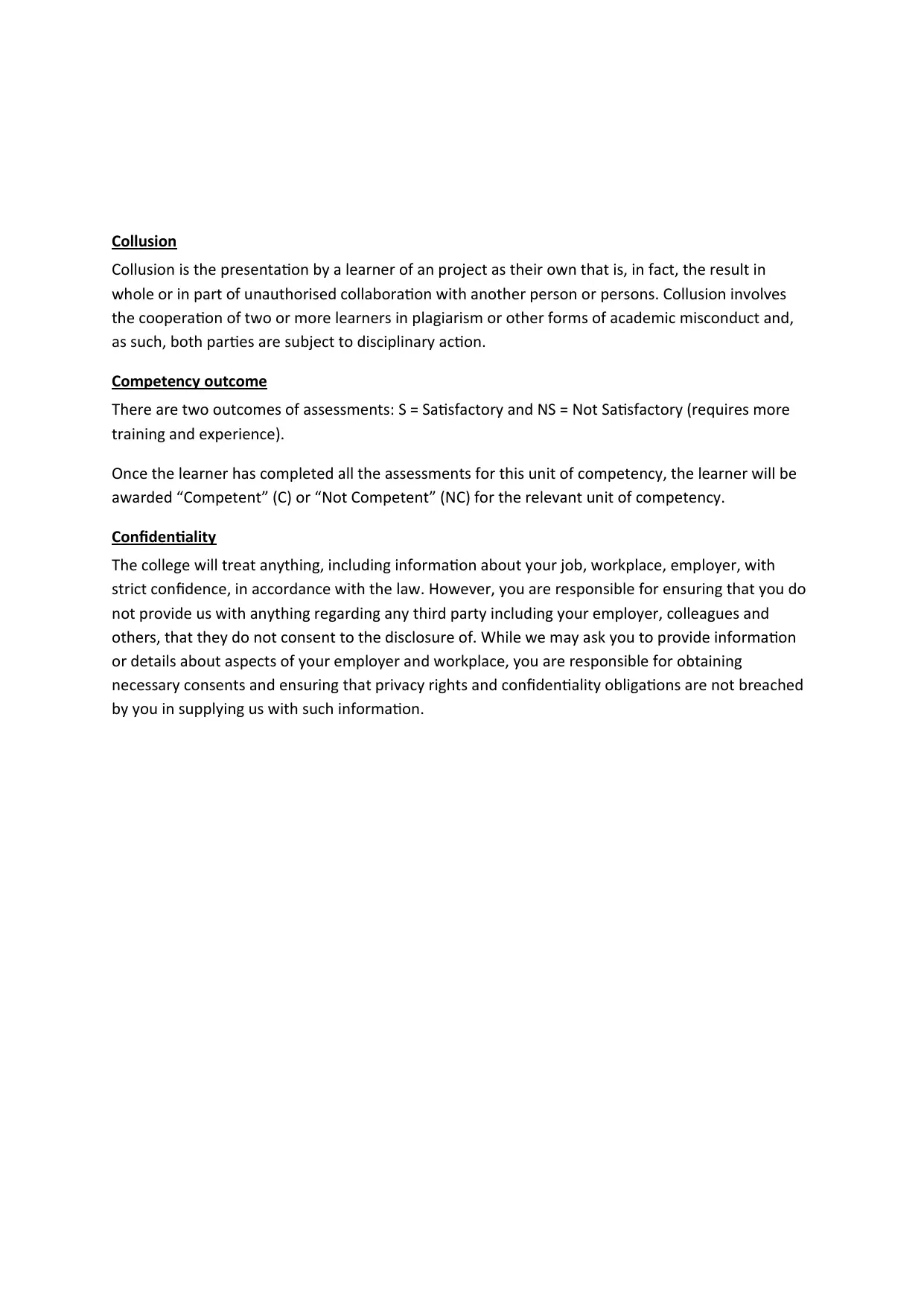
Collusion
Collusion is the presentation by a learner of an project as their own that is, in fact, the result in
whole or in part of unauthorised collaboration with another person or persons. Collusion involves
the cooperation of two or more learners in plagiarism or other forms of academic misconduct and,
as such, both parties are subject to disciplinary action.
Competency outcome
There are two outcomes of assessments: S = Satisfactory and NS = Not Satisfactory (requires more
training and experience).
Once the learner has completed all the assessments for this unit of competency, the learner will be
awarded “Competent” (C) or “Not Competent” (NC) for the relevant unit of competency.
Confidentiality
The college will treat anything, including information about your job, workplace, employer, with
strict confidence, in accordance with the law. However, you are responsible for ensuring that you do
not provide us with anything regarding any third party including your employer, colleagues and
others, that they do not consent to the disclosure of. While we may ask you to provide information
or details about aspects of your employer and workplace, you are responsible for obtaining
necessary consents and ensuring that privacy rights and confidentiality obligations are not breached
by you in supplying us with such information.
Collusion is the presentation by a learner of an project as their own that is, in fact, the result in
whole or in part of unauthorised collaboration with another person or persons. Collusion involves
the cooperation of two or more learners in plagiarism or other forms of academic misconduct and,
as such, both parties are subject to disciplinary action.
Competency outcome
There are two outcomes of assessments: S = Satisfactory and NS = Not Satisfactory (requires more
training and experience).
Once the learner has completed all the assessments for this unit of competency, the learner will be
awarded “Competent” (C) or “Not Competent” (NC) for the relevant unit of competency.
Confidentiality
The college will treat anything, including information about your job, workplace, employer, with
strict confidence, in accordance with the law. However, you are responsible for ensuring that you do
not provide us with anything regarding any third party including your employer, colleagues and
others, that they do not consent to the disclosure of. While we may ask you to provide information
or details about aspects of your employer and workplace, you are responsible for obtaining
necessary consents and ensuring that privacy rights and confidentiality obligations are not breached
by you in supplying us with such information.
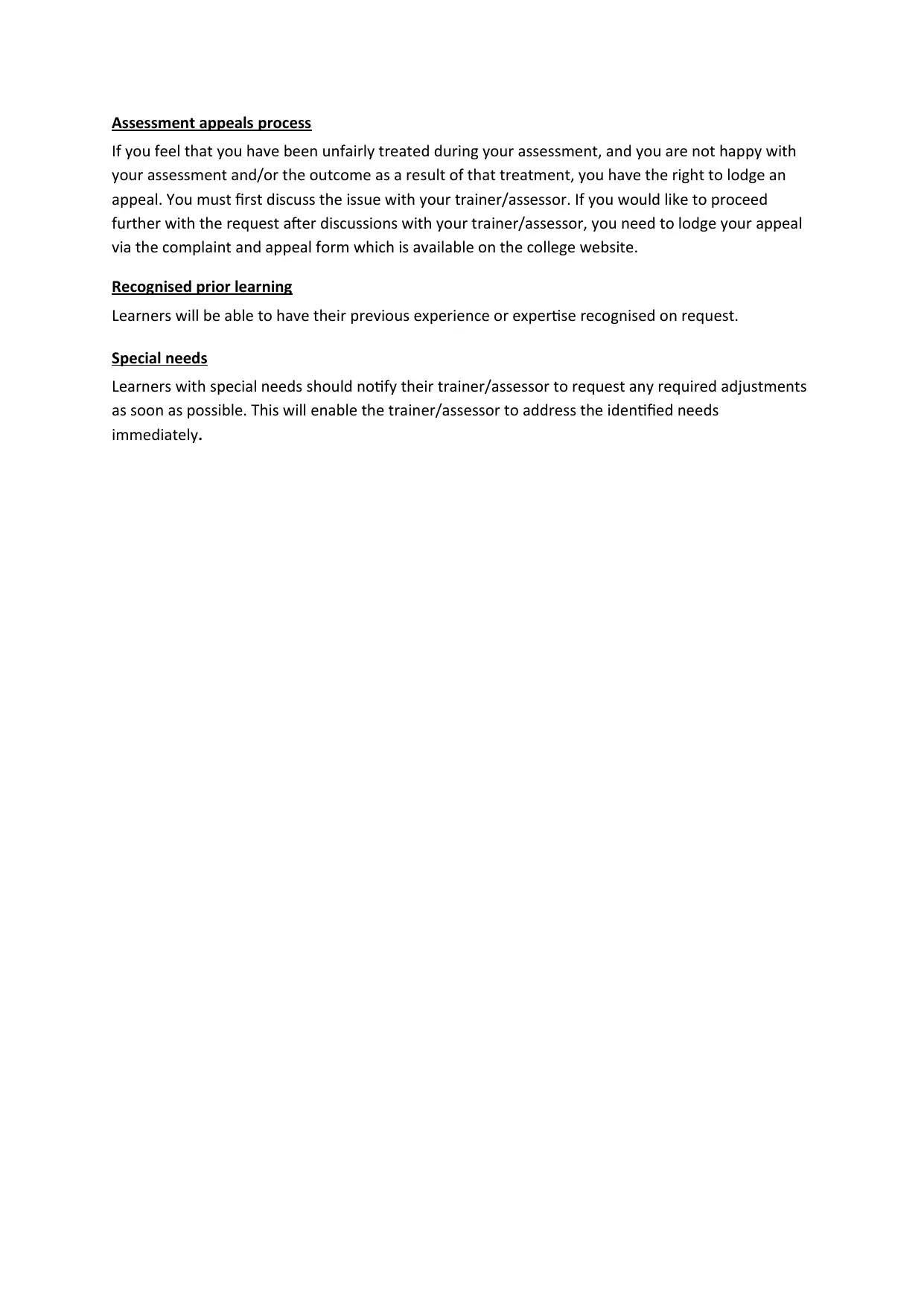
Assessment appeals process
If you feel that you have been unfairly treated during your assessment, and you are not happy with
your assessment and/or the outcome as a result of that treatment, you have the right to lodge an
appeal. You must first discuss the issue with your trainer/assessor. If you would like to proceed
further with the request after discussions with your trainer/assessor, you need to lodge your appeal
via the complaint and appeal form which is available on the college website.
Recognised prior learning
Learners will be able to have their previous experience or expertise recognised on request.
Special needs
Learners with special needs should notify their trainer/assessor to request any required adjustments
as soon as possible. This will enable the trainer/assessor to address the identified needs
immediately .
If you feel that you have been unfairly treated during your assessment, and you are not happy with
your assessment and/or the outcome as a result of that treatment, you have the right to lodge an
appeal. You must first discuss the issue with your trainer/assessor. If you would like to proceed
further with the request after discussions with your trainer/assessor, you need to lodge your appeal
via the complaint and appeal form which is available on the college website.
Recognised prior learning
Learners will be able to have their previous experience or expertise recognised on request.
Special needs
Learners with special needs should notify their trainer/assessor to request any required adjustments
as soon as possible. This will enable the trainer/assessor to address the identified needs
immediately .
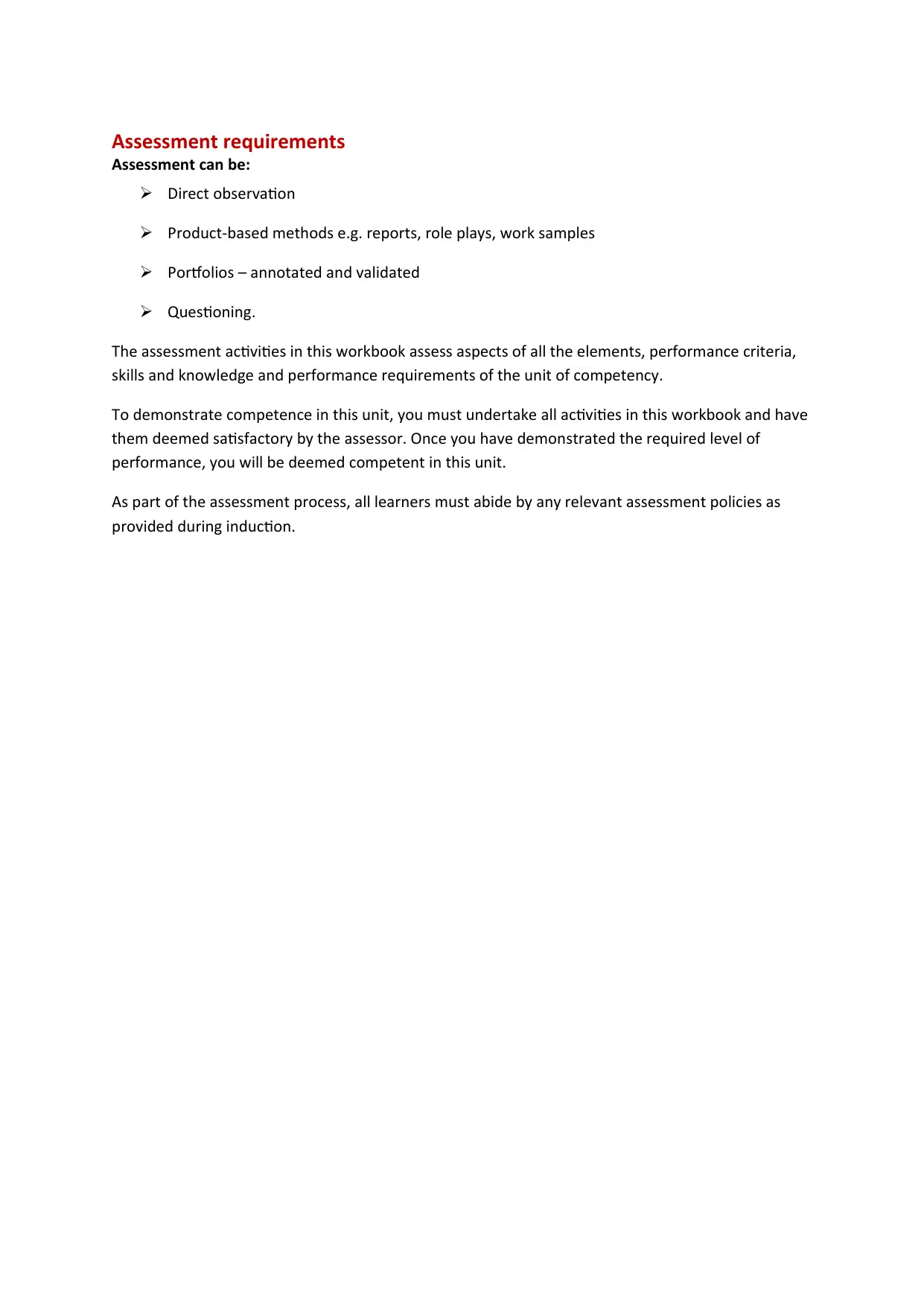
Assessment requirements
Assessment can be:
Direct observation
Product-based methods e.g. reports, role plays, work samples
Portfolios – annotated and validated
Questioning.
The assessment activities in this workbook assess aspects of all the elements, performance criteria,
skills and knowledge and performance requirements of the unit of competency.
To demonstrate competence in this unit, you must undertake all activities in this workbook and have
them deemed satisfactory by the assessor. Once you have demonstrated the required level of
performance, you will be deemed competent in this unit.
As part of the assessment process, all learners must abide by any relevant assessment policies as
provided during induction.
Assessment can be:
Direct observation
Product-based methods e.g. reports, role plays, work samples
Portfolios – annotated and validated
Questioning.
The assessment activities in this workbook assess aspects of all the elements, performance criteria,
skills and knowledge and performance requirements of the unit of competency.
To demonstrate competence in this unit, you must undertake all activities in this workbook and have
them deemed satisfactory by the assessor. Once you have demonstrated the required level of
performance, you will be deemed competent in this unit.
As part of the assessment process, all learners must abide by any relevant assessment policies as
provided during induction.
Paraphrase This Document
Need a fresh take? Get an instant paraphrase of this document with our AI Paraphraser

Candidate Details
Assessment – BSBMGT608: Manage innovation and continuous improvement
Please complete the following activities and hand in to your trainer/assessor for marking. This forms
part of your assessment for BSBMGT608: Manage innovation and continuous improvement.
Name: _____________________________________________________________
Address: _____________________________________________________________
_____________________________________________________________
Email: _____________________________________________________________
Employer: _____________________________________________________________
Declaration
I declare that no part of this assessment has been copied from another person’s work with the
exception of where I have listed or referenced documents or work and that no part of this
assessment has been written for me by another person. I also understand the assessment
instructions and requirements and consent to being assessed.
Signed: ____________________________________________________________
Date: ____________________________________________________________
If activities have been completed as part of a small group or in pairs, details of the learners
involved should be provided below:
This activity workbook has been completed by the following persons and we acknowledge that it
was a fair team effort where everyone contributed equally to the work completed. We declare that
no part of this assessment has been copied from another person’s work with the exception of where
we have listed or referenced documents or work and that no part of this assessment has been
written for us by another person.
Learner 1: ____________________________________________________________
Signed: ____________________________________________________________
Learner 2: ____________________________________________________________
Signed: ____________________________________________________________
Learner 3: ____________________________________________________________
Signed: ____________________________________________________________
Assessment – BSBMGT608: Manage innovation and continuous improvement
Please complete the following activities and hand in to your trainer/assessor for marking. This forms
part of your assessment for BSBMGT608: Manage innovation and continuous improvement.
Name: _____________________________________________________________
Address: _____________________________________________________________
_____________________________________________________________
Email: _____________________________________________________________
Employer: _____________________________________________________________
Declaration
I declare that no part of this assessment has been copied from another person’s work with the
exception of where I have listed or referenced documents or work and that no part of this
assessment has been written for me by another person. I also understand the assessment
instructions and requirements and consent to being assessed.
Signed: ____________________________________________________________
Date: ____________________________________________________________
If activities have been completed as part of a small group or in pairs, details of the learners
involved should be provided below:
This activity workbook has been completed by the following persons and we acknowledge that it
was a fair team effort where everyone contributed equally to the work completed. We declare that
no part of this assessment has been copied from another person’s work with the exception of where
we have listed or referenced documents or work and that no part of this assessment has been
written for us by another person.
Learner 1: ____________________________________________________________
Signed: ____________________________________________________________
Learner 2: ____________________________________________________________
Signed: ____________________________________________________________
Learner 3: ____________________________________________________________
Signed: ____________________________________________________________
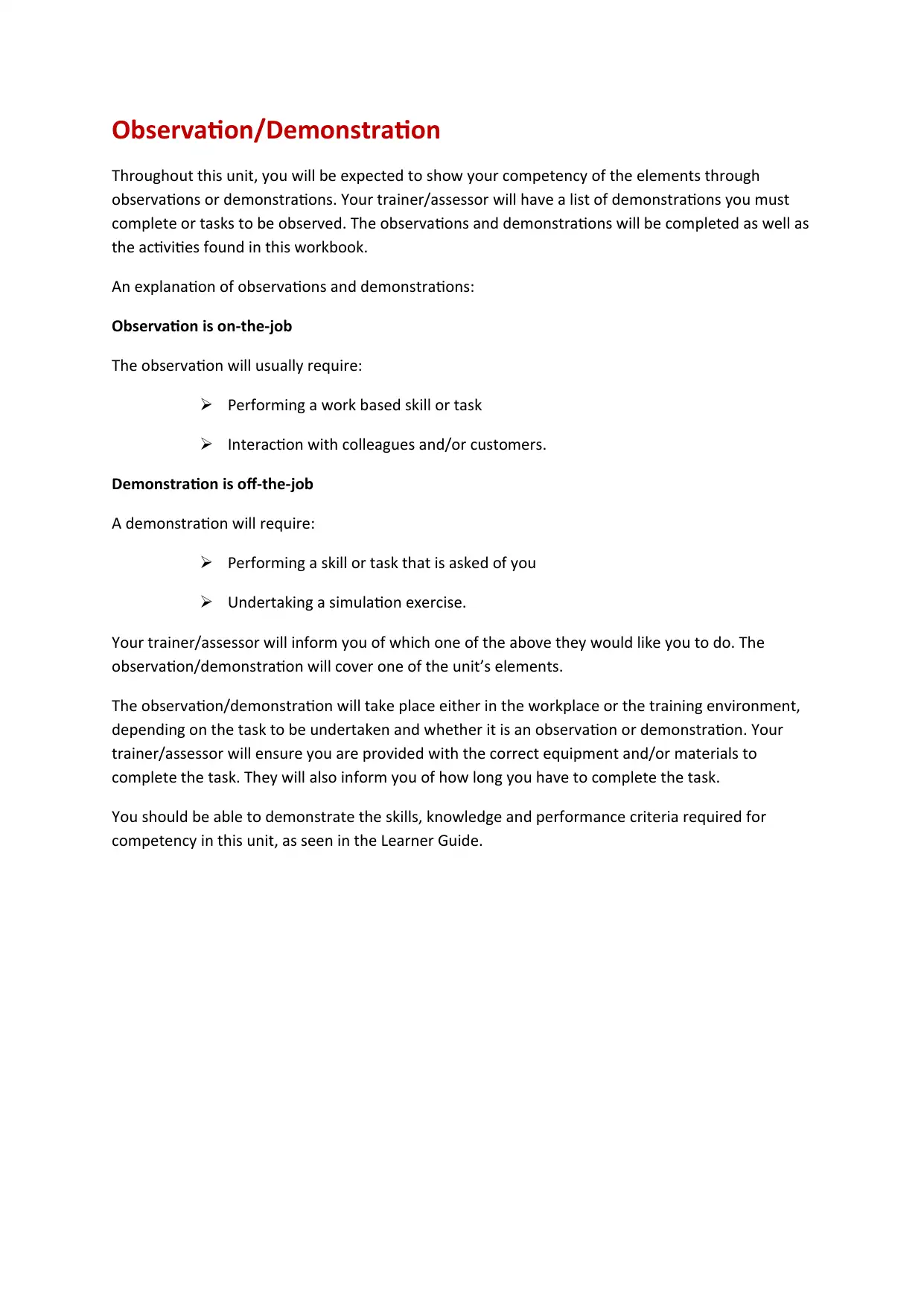
Observation/Demonstration
Throughout this unit, you will be expected to show your competency of the elements through
observations or demonstrations. Your trainer/assessor will have a list of demonstrations you must
complete or tasks to be observed. The observations and demonstrations will be completed as well as
the activities found in this workbook.
An explanation of observations and demonstrations:
Observation is on-the-job
The observation will usually require:
Performing a work based skill or task
Interaction with colleagues and/or customers.
Demonstration is off-the-job
A demonstration will require:
Performing a skill or task that is asked of you
Undertaking a simulation exercise.
Your trainer/assessor will inform you of which one of the above they would like you to do. The
observation/demonstration will cover one of the unit’s elements.
The observation/demonstration will take place either in the workplace or the training environment,
depending on the task to be undertaken and whether it is an observation or demonstration. Your
trainer/assessor will ensure you are provided with the correct equipment and/or materials to
complete the task. They will also inform you of how long you have to complete the task.
You should be able to demonstrate the skills, knowledge and performance criteria required for
competency in this unit, as seen in the Learner Guide.
Throughout this unit, you will be expected to show your competency of the elements through
observations or demonstrations. Your trainer/assessor will have a list of demonstrations you must
complete or tasks to be observed. The observations and demonstrations will be completed as well as
the activities found in this workbook.
An explanation of observations and demonstrations:
Observation is on-the-job
The observation will usually require:
Performing a work based skill or task
Interaction with colleagues and/or customers.
Demonstration is off-the-job
A demonstration will require:
Performing a skill or task that is asked of you
Undertaking a simulation exercise.
Your trainer/assessor will inform you of which one of the above they would like you to do. The
observation/demonstration will cover one of the unit’s elements.
The observation/demonstration will take place either in the workplace or the training environment,
depending on the task to be undertaken and whether it is an observation or demonstration. Your
trainer/assessor will ensure you are provided with the correct equipment and/or materials to
complete the task. They will also inform you of how long you have to complete the task.
You should be able to demonstrate the skills, knowledge and performance criteria required for
competency in this unit, as seen in the Learner Guide.
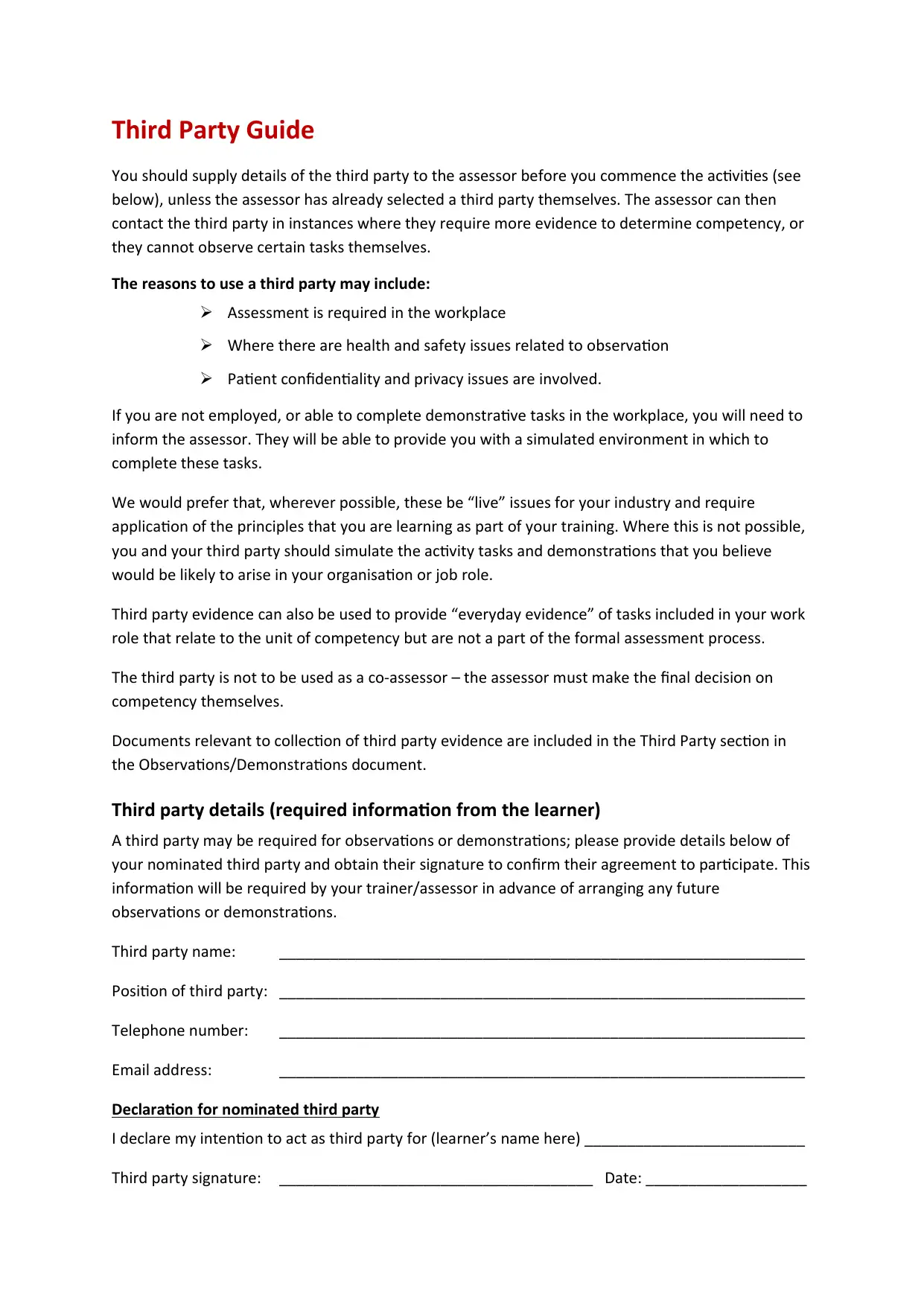
Third Party Guide
You should supply details of the third party to the assessor before you commence the activities (see
below), unless the assessor has already selected a third party themselves. The assessor can then
contact the third party in instances where they require more evidence to determine competency, or
they cannot observe certain tasks themselves.
The reasons to use a third party may include:
Assessment is required in the workplace
Where there are health and safety issues related to observation
Patient confidentiality and privacy issues are involved.
If you are not employed, or able to complete demonstrative tasks in the workplace, you will need to
inform the assessor. They will be able to provide you with a simulated environment in which to
complete these tasks.
We would prefer that, wherever possible, these be “live” issues for your industry and require
application of the principles that you are learning as part of your training. Where this is not possible,
you and your third party should simulate the activity tasks and demonstrations that you believe
would be likely to arise in your organisation or job role.
Third party evidence can also be used to provide “everyday evidence” of tasks included in your work
role that relate to the unit of competency but are not a part of the formal assessment process.
The third party is not to be used as a co-assessor – the assessor must make the final decision on
competency themselves.
Documents relevant to collection of third party evidence are included in the Third Party section in
the Observations/Demonstrations document.
Third party details (required information from the learner)
A third party may be required for observations or demonstrations; please provide details below of
your nominated third party and obtain their signature to confirm their agreement to participate. This
information will be required by your trainer/assessor in advance of arranging any future
observations or demonstrations.
Third party name: ______________________________________________________________
Position of third party: ______________________________________________________________
Telephone number: ______________________________________________________________
Email address: ______________________________________________________________
Declaration for nominated third party
I declare my intention to act as third party for (learner’s name here) __________________________
Third party signature: _____________________________________ Date: ___________________
You should supply details of the third party to the assessor before you commence the activities (see
below), unless the assessor has already selected a third party themselves. The assessor can then
contact the third party in instances where they require more evidence to determine competency, or
they cannot observe certain tasks themselves.
The reasons to use a third party may include:
Assessment is required in the workplace
Where there are health and safety issues related to observation
Patient confidentiality and privacy issues are involved.
If you are not employed, or able to complete demonstrative tasks in the workplace, you will need to
inform the assessor. They will be able to provide you with a simulated environment in which to
complete these tasks.
We would prefer that, wherever possible, these be “live” issues for your industry and require
application of the principles that you are learning as part of your training. Where this is not possible,
you and your third party should simulate the activity tasks and demonstrations that you believe
would be likely to arise in your organisation or job role.
Third party evidence can also be used to provide “everyday evidence” of tasks included in your work
role that relate to the unit of competency but are not a part of the formal assessment process.
The third party is not to be used as a co-assessor – the assessor must make the final decision on
competency themselves.
Documents relevant to collection of third party evidence are included in the Third Party section in
the Observations/Demonstrations document.
Third party details (required information from the learner)
A third party may be required for observations or demonstrations; please provide details below of
your nominated third party and obtain their signature to confirm their agreement to participate. This
information will be required by your trainer/assessor in advance of arranging any future
observations or demonstrations.
Third party name: ______________________________________________________________
Position of third party: ______________________________________________________________
Telephone number: ______________________________________________________________
Email address: ______________________________________________________________
Declaration for nominated third party
I declare my intention to act as third party for (learner’s name here) __________________________
Third party signature: _____________________________________ Date: ___________________
Secure Best Marks with AI Grader
Need help grading? Try our AI Grader for instant feedback on your assignments.
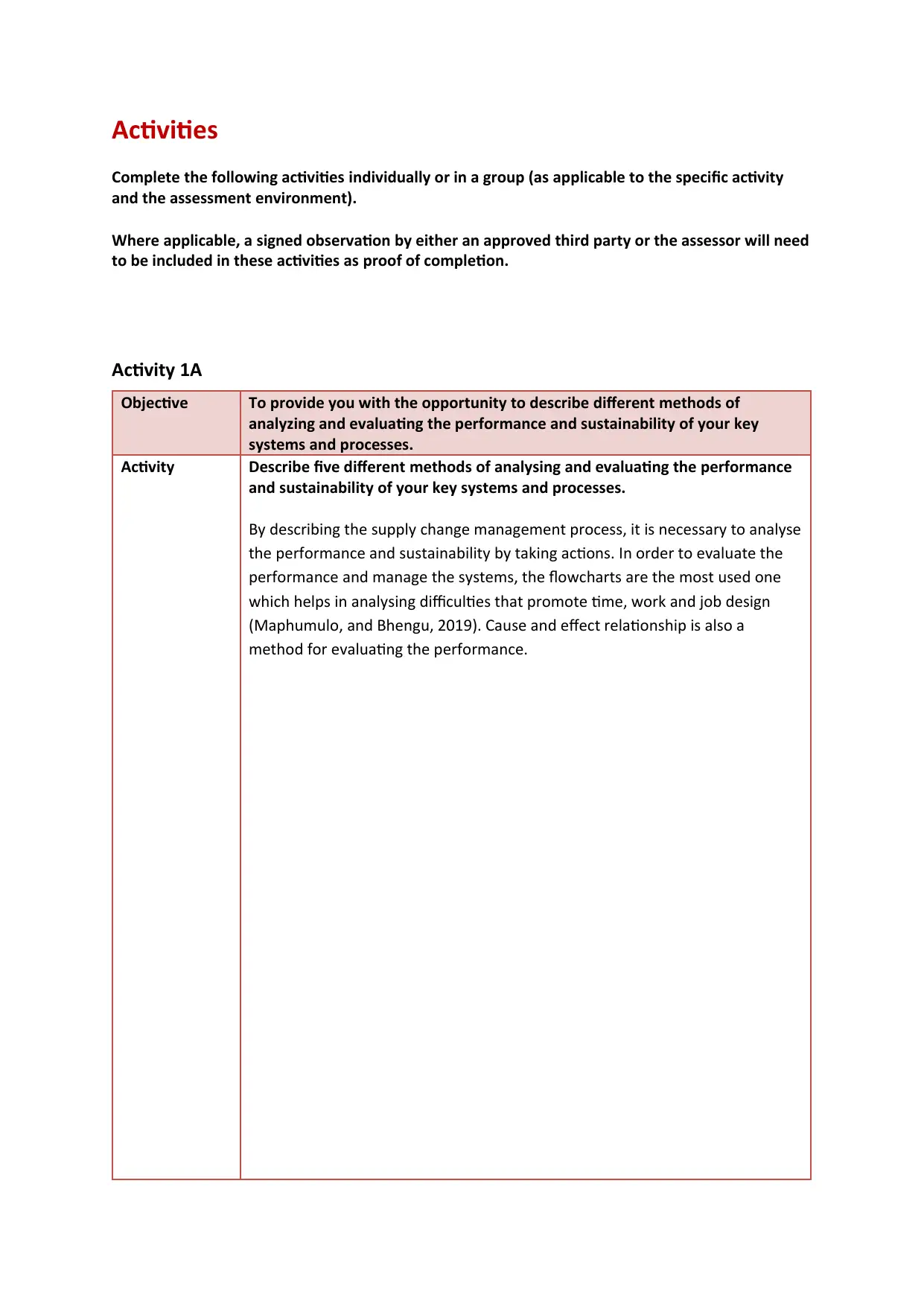
Activities
Complete the following activities individually or in a group (as applicable to the specific activity
and the assessment environment).
Where applicable, a signed observation by either an approved third party or the assessor will need
to be included in these activities as proof of completion.
Activity 1A
Objective To provide you with the opportunity to describe different methods of
analyzing and evaluating the performance and sustainability of your key
systems and processes.
Activity Describe five different methods of analysing and evaluating the performance
and sustainability of your key systems and processes.
By describing the supply change management process, it is necessary to analyse
the performance and sustainability by taking actions. In order to evaluate the
performance and manage the systems, the flowcharts are the most used one
which helps in analysing difficulties that promote time, work and job design
(Maphumulo, and Bhengu, 2019). Cause and effect relationship is also a
method for evaluating the performance.
Complete the following activities individually or in a group (as applicable to the specific activity
and the assessment environment).
Where applicable, a signed observation by either an approved third party or the assessor will need
to be included in these activities as proof of completion.
Activity 1A
Objective To provide you with the opportunity to describe different methods of
analyzing and evaluating the performance and sustainability of your key
systems and processes.
Activity Describe five different methods of analysing and evaluating the performance
and sustainability of your key systems and processes.
By describing the supply change management process, it is necessary to analyse
the performance and sustainability by taking actions. In order to evaluate the
performance and manage the systems, the flowcharts are the most used one
which helps in analysing difficulties that promote time, work and job design
(Maphumulo, and Bhengu, 2019). Cause and effect relationship is also a
method for evaluating the performance.

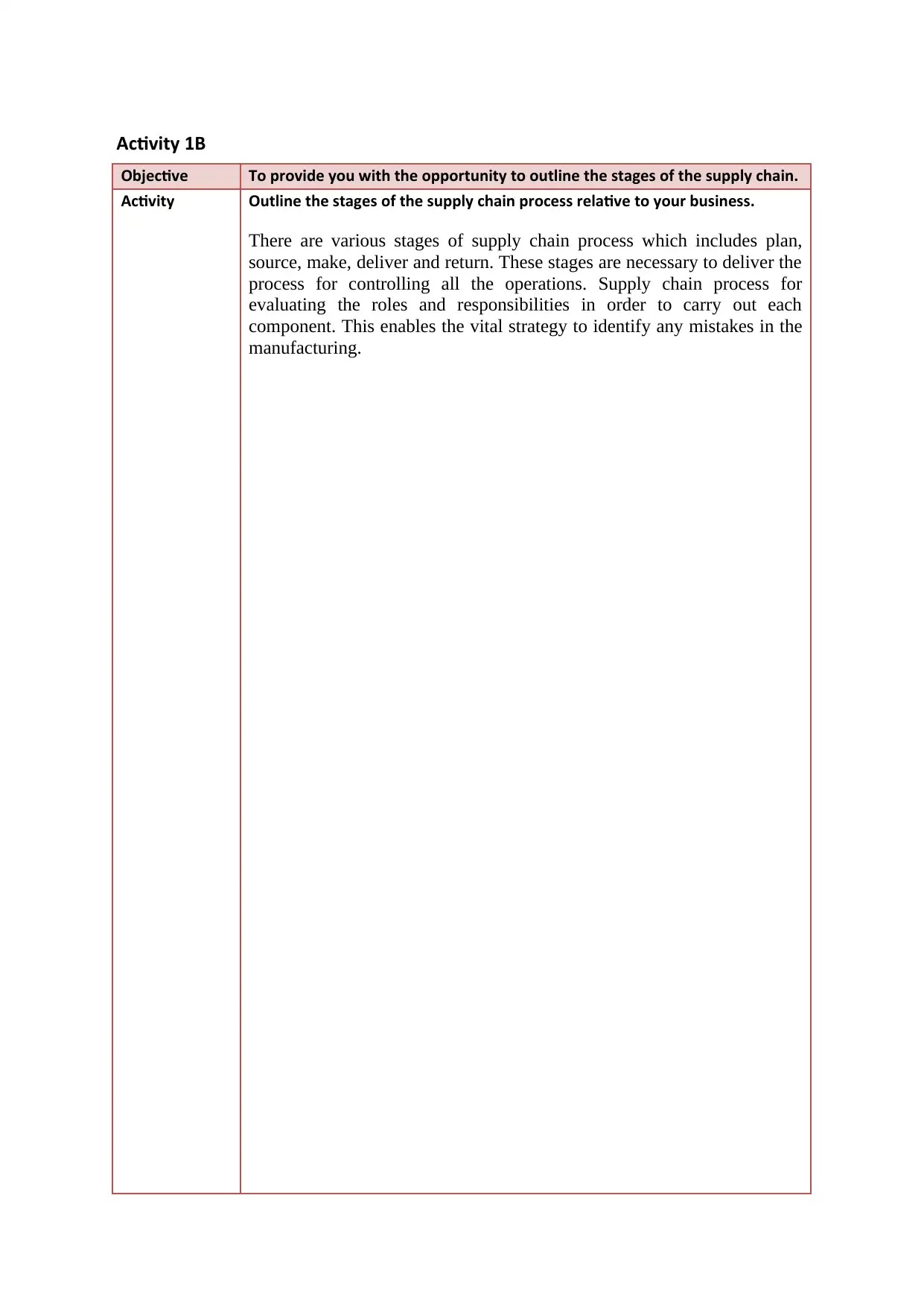
Activity 1B
Objective To provide you with the opportunity to outline the stages of the supply chain.
Activity Outline the stages of the supply chain process relative to your business.
There are various stages of supply chain process which includes plan,
source, make, deliver and return. These stages are necessary to deliver the
process for controlling all the operations. Supply chain process for
evaluating the roles and responsibilities in order to carry out each
component. This enables the vital strategy to identify any mistakes in the
manufacturing.
Objective To provide you with the opportunity to outline the stages of the supply chain.
Activity Outline the stages of the supply chain process relative to your business.
There are various stages of supply chain process which includes plan,
source, make, deliver and return. These stages are necessary to deliver the
process for controlling all the operations. Supply chain process for
evaluating the roles and responsibilities in order to carry out each
component. This enables the vital strategy to identify any mistakes in the
manufacturing.
Paraphrase This Document
Need a fresh take? Get an instant paraphrase of this document with our AI Paraphraser
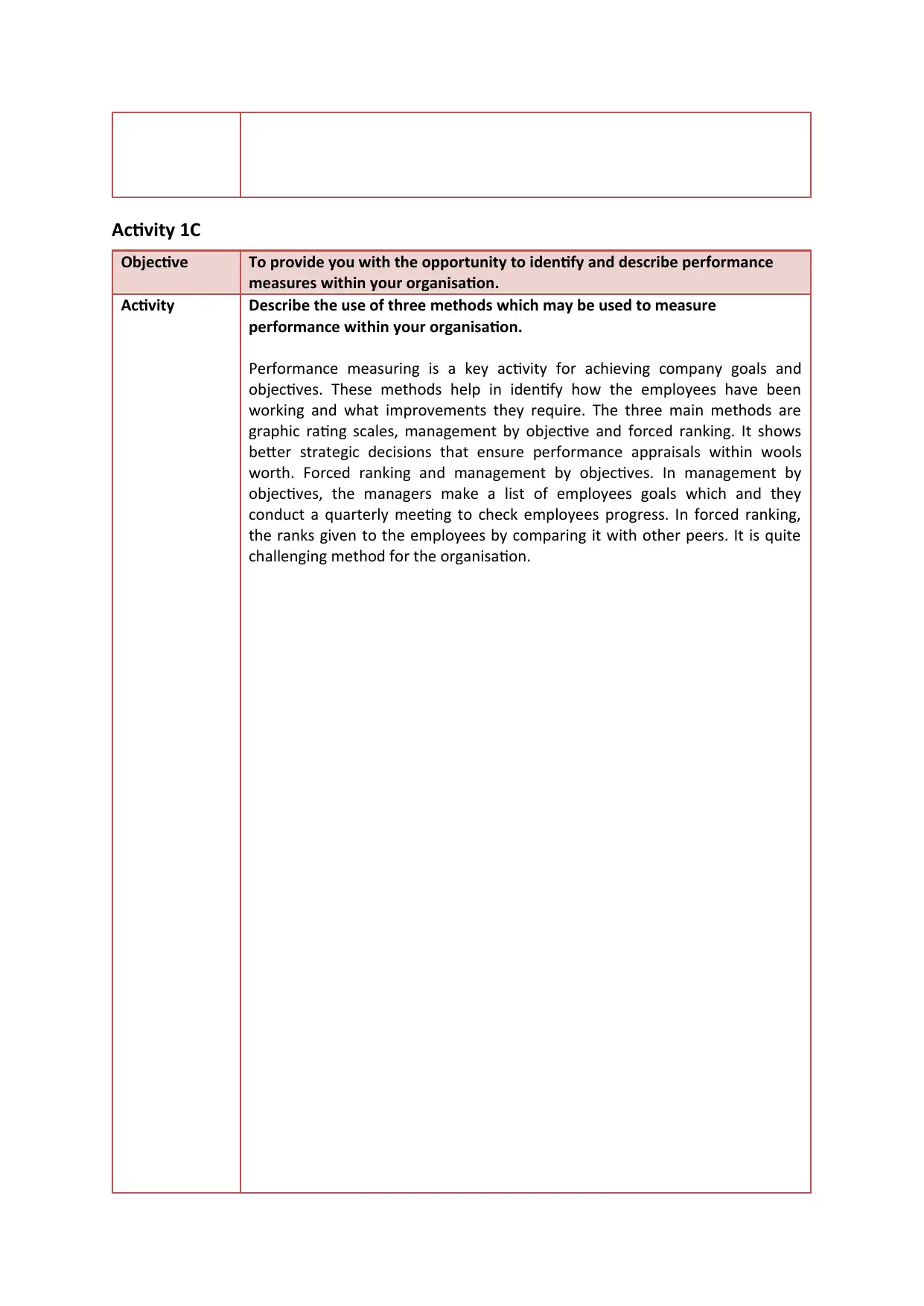
Activity 1C
Objective To provide you with the opportunity to identify and describe performance
measures within your organisation.
Activity Describe the use of three methods which may be used to measure
performance within your organisation.
Performance measuring is a key activity for achieving company goals and
objectives. These methods help in identify how the employees have been
working and what improvements they require. The three main methods are
graphic rating scales, management by objective and forced ranking. It shows
better strategic decisions that ensure performance appraisals within wools
worth. Forced ranking and management by objectives. In management by
objectives, the managers make a list of employees goals which and they
conduct a quarterly meeting to check employees progress. In forced ranking,
the ranks given to the employees by comparing it with other peers. It is quite
challenging method for the organisation.
Objective To provide you with the opportunity to identify and describe performance
measures within your organisation.
Activity Describe the use of three methods which may be used to measure
performance within your organisation.
Performance measuring is a key activity for achieving company goals and
objectives. These methods help in identify how the employees have been
working and what improvements they require. The three main methods are
graphic rating scales, management by objective and forced ranking. It shows
better strategic decisions that ensure performance appraisals within wools
worth. Forced ranking and management by objectives. In management by
objectives, the managers make a list of employees goals which and they
conduct a quarterly meeting to check employees progress. In forced ranking,
the ranks given to the employees by comparing it with other peers. It is quite
challenging method for the organisation.
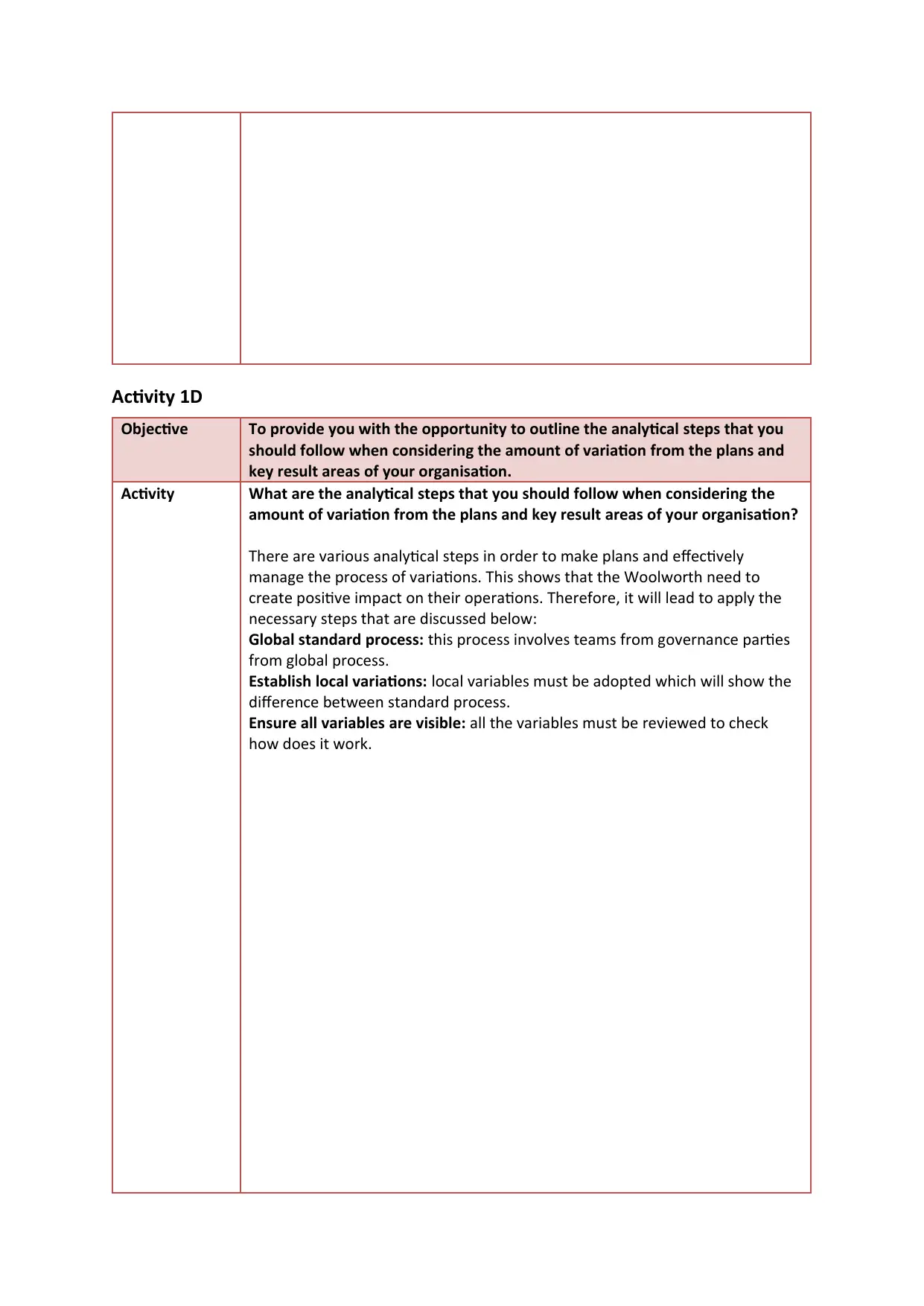
Activity 1D
Objective To provide you with the opportunity to outline the analytical steps that you
should follow when considering the amount of variation from the plans and
key result areas of your organisation.
Activity What are the analytical steps that you should follow when considering the
amount of variation from the plans and key result areas of your organisation?
There are various analytical steps in order to make plans and effectively
manage the process of variations. This shows that the Woolworth need to
create positive impact on their operations. Therefore, it will lead to apply the
necessary steps that are discussed below:
Global standard process: this process involves teams from governance parties
from global process.
Establish local variations: local variables must be adopted which will show the
difference between standard process.
Ensure all variables are visible: all the variables must be reviewed to check
how does it work.
Objective To provide you with the opportunity to outline the analytical steps that you
should follow when considering the amount of variation from the plans and
key result areas of your organisation.
Activity What are the analytical steps that you should follow when considering the
amount of variation from the plans and key result areas of your organisation?
There are various analytical steps in order to make plans and effectively
manage the process of variations. This shows that the Woolworth need to
create positive impact on their operations. Therefore, it will lead to apply the
necessary steps that are discussed below:
Global standard process: this process involves teams from governance parties
from global process.
Establish local variations: local variables must be adopted which will show the
difference between standard process.
Ensure all variables are visible: all the variables must be reviewed to check
how does it work.

Secure Best Marks with AI Grader
Need help grading? Try our AI Grader for instant feedback on your assignments.

Activity 1E
Objective To provide you with the opportunity to describe/identify sources of trends
and types of trend analysis.
Activity 1. Describe three sources of information about trends specific to your
business
Trend is all about forecasting the future stock which is going to use in the
further production. It is used in technical analyses. The trends can be identified
in Woolworth through analysing the industry newsletters, journals, magazines.
Also, social media is a great option which will helps in analysing better
strategies to promote the company in overall market and maintain the stock.
2. Name the three types of trend analysis
Geographic, temporal and intuitive.
Objective To provide you with the opportunity to describe/identify sources of trends
and types of trend analysis.
Activity 1. Describe three sources of information about trends specific to your
business
Trend is all about forecasting the future stock which is going to use in the
further production. It is used in technical analyses. The trends can be identified
in Woolworth through analysing the industry newsletters, journals, magazines.
Also, social media is a great option which will helps in analysing better
strategies to promote the company in overall market and maintain the stock.
2. Name the three types of trend analysis
Geographic, temporal and intuitive.
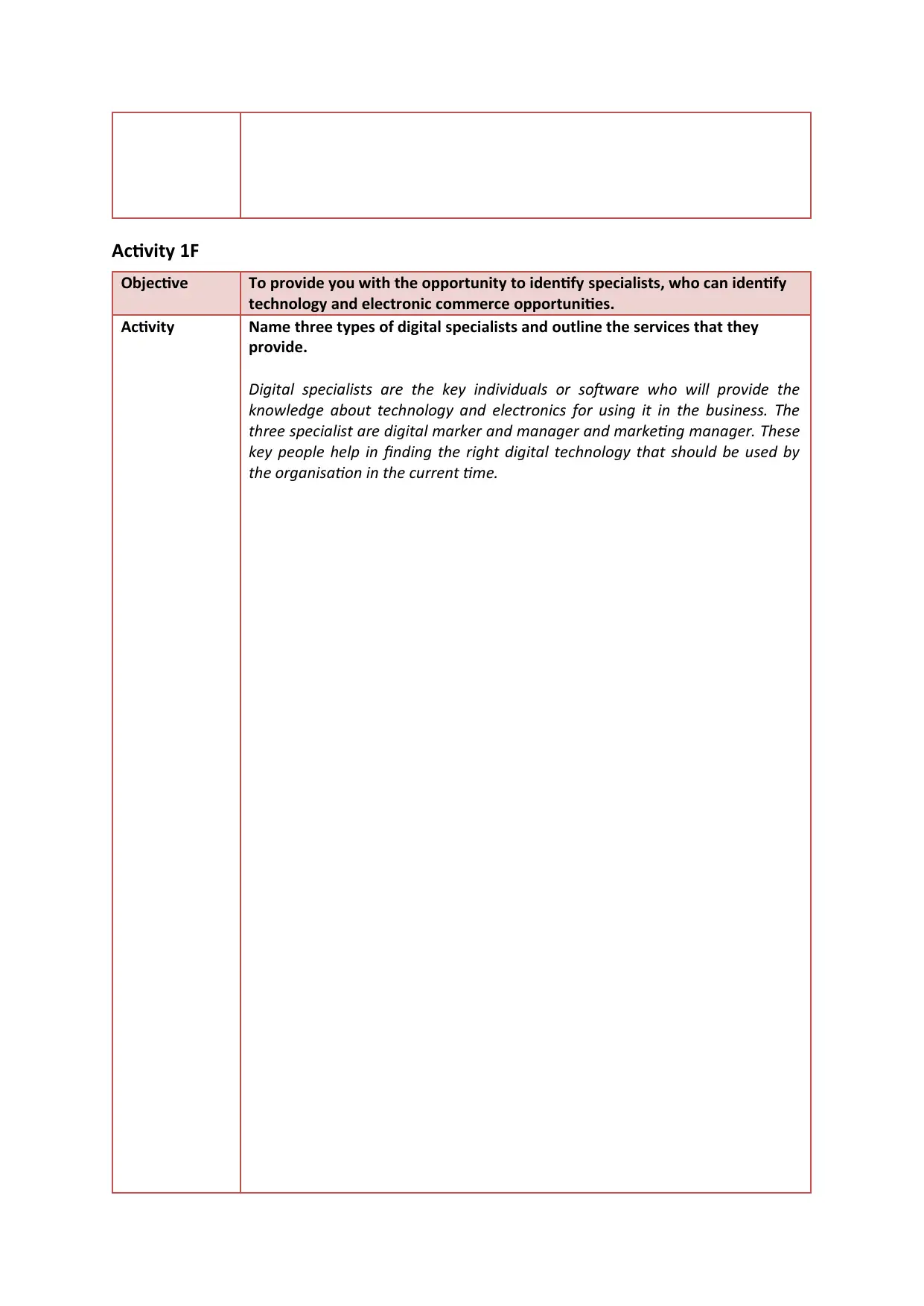
Activity 1F
Objective To provide you with the opportunity to identify specialists, who can identify
technology and electronic commerce opportunities.
Activity Name three types of digital specialists and outline the services that they
provide.
Digital specialists are the key individuals or software who will provide the
knowledge about technology and electronics for using it in the business. The
three specialist are digital marker and manager and marketing manager. These
key people help in finding the right digital technology that should be used by
the organisation in the current time.
Objective To provide you with the opportunity to identify specialists, who can identify
technology and electronic commerce opportunities.
Activity Name three types of digital specialists and outline the services that they
provide.
Digital specialists are the key individuals or software who will provide the
knowledge about technology and electronics for using it in the business. The
three specialist are digital marker and manager and marketing manager. These
key people help in finding the right digital technology that should be used by
the organisation in the current time.
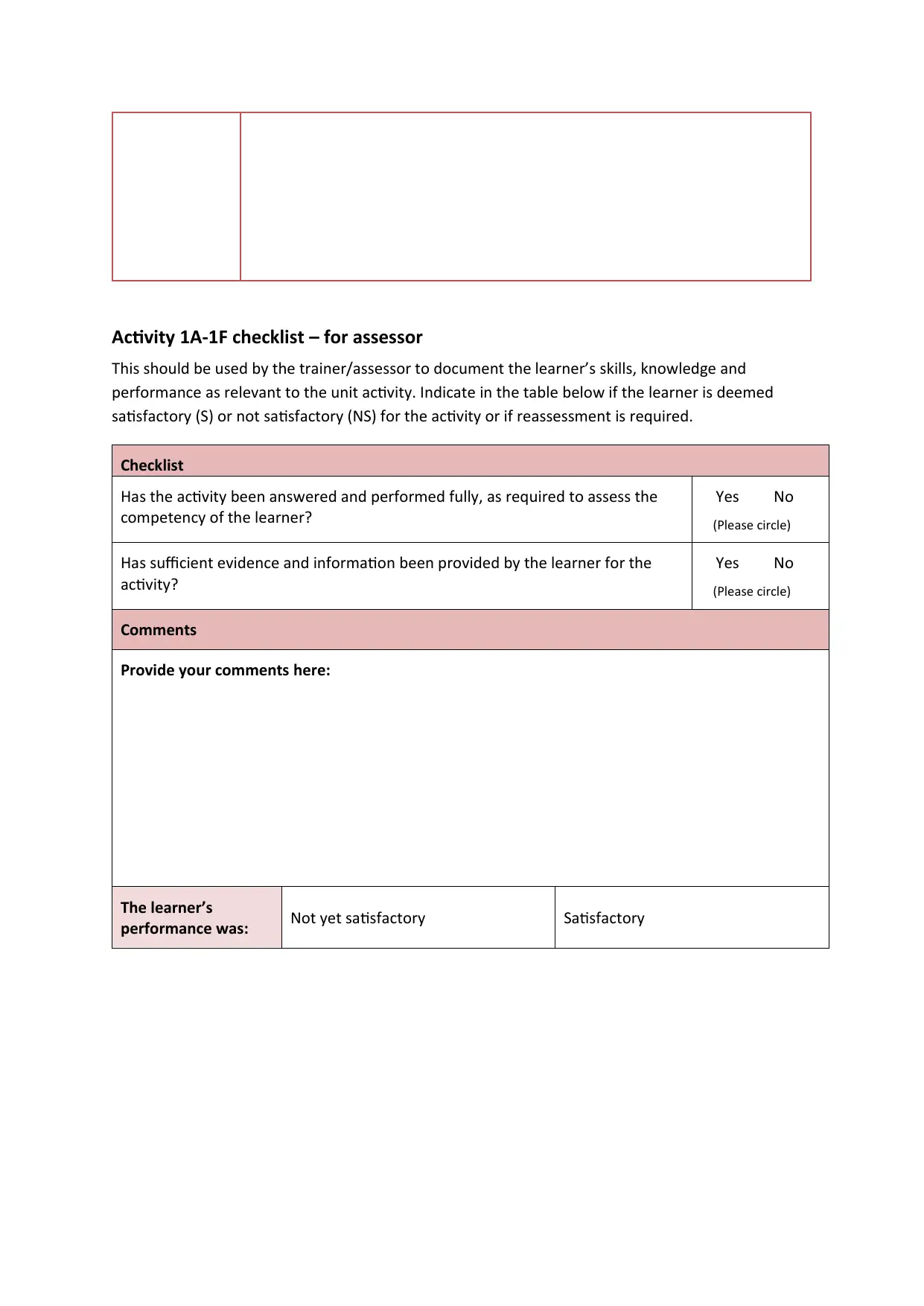
Activity 1A-1F checklist – for assessor
This should be used by the trainer/assessor to document the learner’s skills, knowledge and
performance as relevant to the unit activity. Indicate in the table below if the learner is deemed
satisfactory (S) or not satisfactory (NS) for the activity or if reassessment is required.
Checklist
Has the activity been answered and performed fully, as required to assess the
competency of the learner?
Yes No
(Please circle)
Has sufficient evidence and information been provided by the learner for the
activity?
Yes No
(Please circle)
Comments
Provide your comments here:
The learner’s
performance was: Not yet satisfactory Satisfactory
This should be used by the trainer/assessor to document the learner’s skills, knowledge and
performance as relevant to the unit activity. Indicate in the table below if the learner is deemed
satisfactory (S) or not satisfactory (NS) for the activity or if reassessment is required.
Checklist
Has the activity been answered and performed fully, as required to assess the
competency of the learner?
Yes No
(Please circle)
Has sufficient evidence and information been provided by the learner for the
activity?
Yes No
(Please circle)
Comments
Provide your comments here:
The learner’s
performance was: Not yet satisfactory Satisfactory
Paraphrase This Document
Need a fresh take? Get an instant paraphrase of this document with our AI Paraphraser
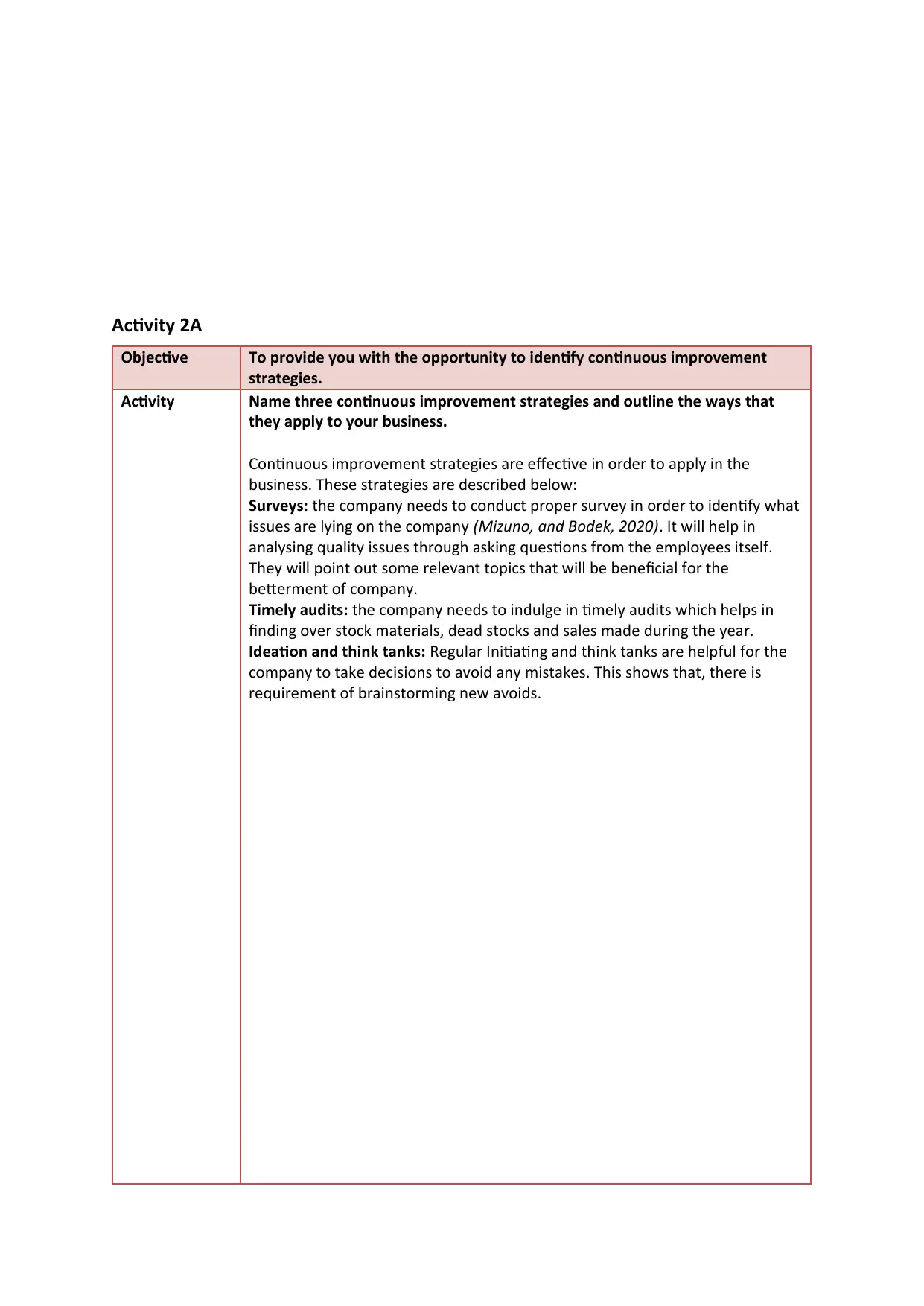
Activity 2A
Objective To provide you with the opportunity to identify continuous improvement
strategies.
Activity Name three continuous improvement strategies and outline the ways that
they apply to your business.
Continuous improvement strategies are effective in order to apply in the
business. These strategies are described below:
Surveys: the company needs to conduct proper survey in order to identify what
issues are lying on the company (Mizuno, and Bodek, 2020). It will help in
analysing quality issues through asking questions from the employees itself.
They will point out some relevant topics that will be beneficial for the
betterment of company.
Timely audits: the company needs to indulge in timely audits which helps in
finding over stock materials, dead stocks and sales made during the year.
Ideation and think tanks: Regular Initiating and think tanks are helpful for the
company to take decisions to avoid any mistakes. This shows that, there is
requirement of brainstorming new avoids.
Objective To provide you with the opportunity to identify continuous improvement
strategies.
Activity Name three continuous improvement strategies and outline the ways that
they apply to your business.
Continuous improvement strategies are effective in order to apply in the
business. These strategies are described below:
Surveys: the company needs to conduct proper survey in order to identify what
issues are lying on the company (Mizuno, and Bodek, 2020). It will help in
analysing quality issues through asking questions from the employees itself.
They will point out some relevant topics that will be beneficial for the
betterment of company.
Timely audits: the company needs to indulge in timely audits which helps in
finding over stock materials, dead stocks and sales made during the year.
Ideation and think tanks: Regular Initiating and think tanks are helpful for the
company to take decisions to avoid any mistakes. This shows that, there is
requirement of brainstorming new avoids.
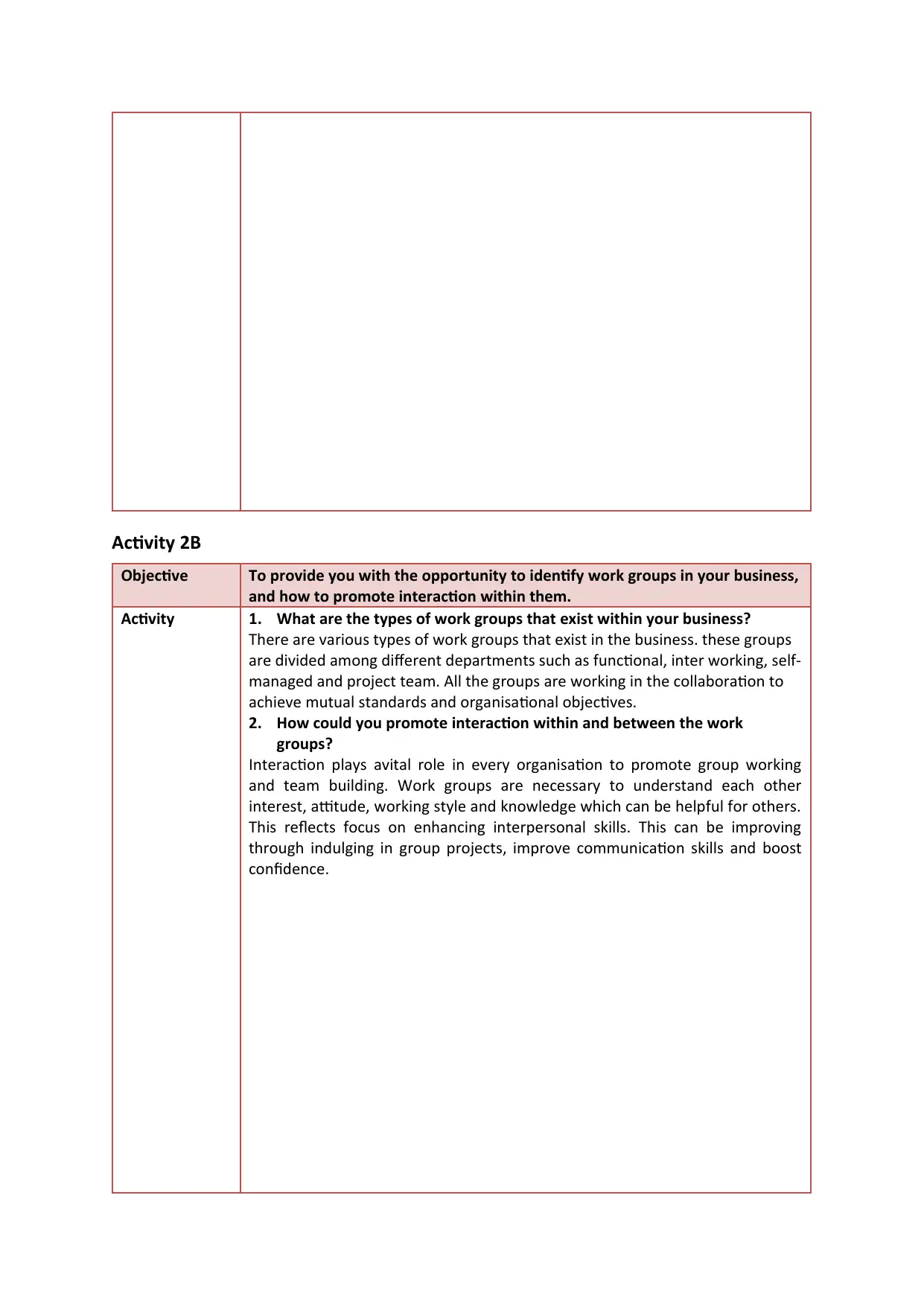
Activity 2B
Objective To provide you with the opportunity to identify work groups in your business,
and how to promote interaction within them.
Activity 1. What are the types of work groups that exist within your business?
There are various types of work groups that exist in the business. these groups
are divided among different departments such as functional, inter working, self-
managed and project team. All the groups are working in the collaboration to
achieve mutual standards and organisational objectives.
2. How could you promote interaction within and between the work
groups?
Interaction plays avital role in every organisation to promote group working
and team building. Work groups are necessary to understand each other
interest, attitude, working style and knowledge which can be helpful for others.
This reflects focus on enhancing interpersonal skills. This can be improving
through indulging in group projects, improve communication skills and boost
confidence.
Objective To provide you with the opportunity to identify work groups in your business,
and how to promote interaction within them.
Activity 1. What are the types of work groups that exist within your business?
There are various types of work groups that exist in the business. these groups
are divided among different departments such as functional, inter working, self-
managed and project team. All the groups are working in the collaboration to
achieve mutual standards and organisational objectives.
2. How could you promote interaction within and between the work
groups?
Interaction plays avital role in every organisation to promote group working
and team building. Work groups are necessary to understand each other
interest, attitude, working style and knowledge which can be helpful for others.
This reflects focus on enhancing interpersonal skills. This can be improving
through indulging in group projects, improve communication skills and boost
confidence.
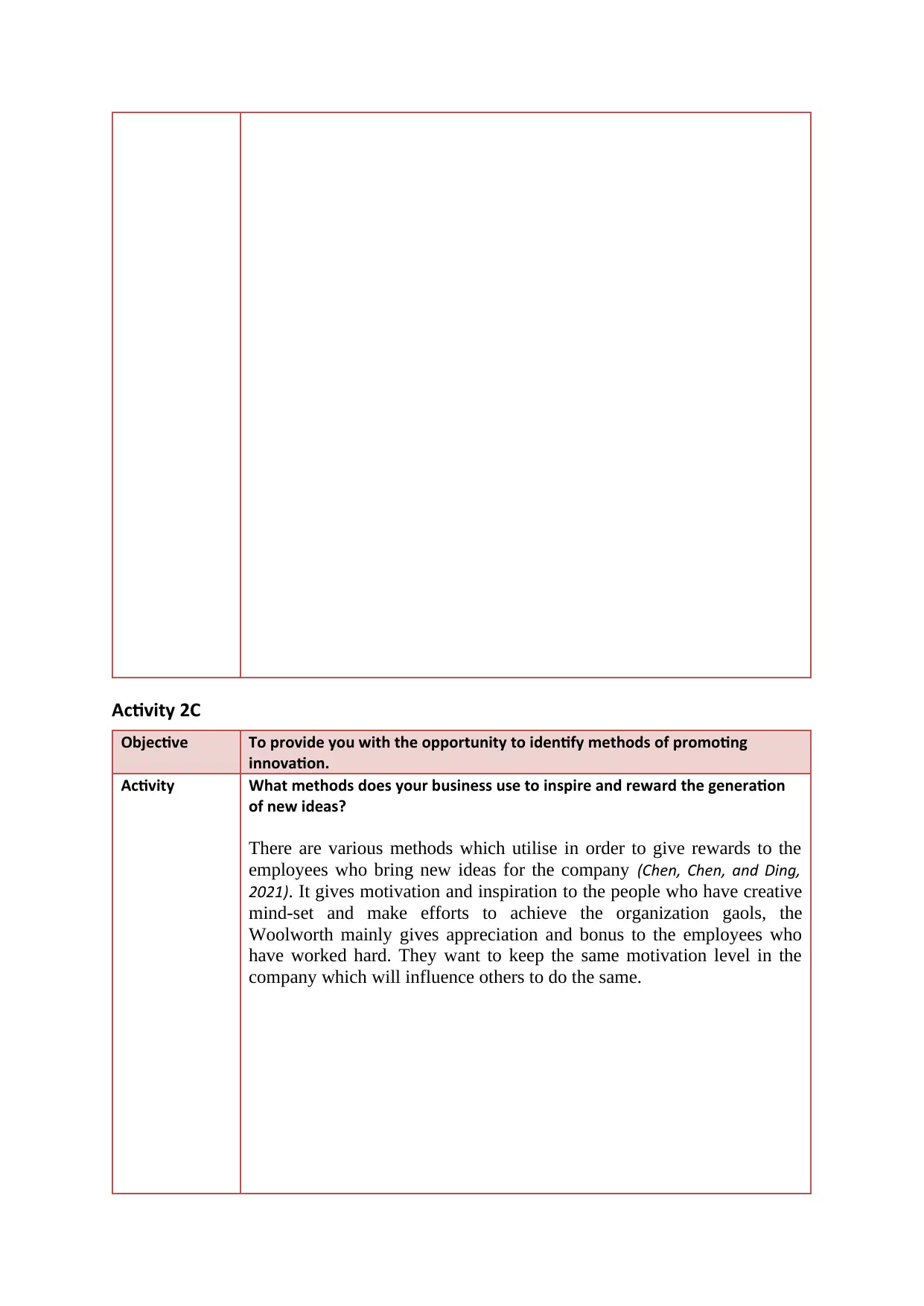
Activity 2C
Objective To provide you with the opportunity to identify methods of promoting
innovation.
Activity What methods does your business use to inspire and reward the generation
of new ideas?
There are various methods which utilise in order to give rewards to the
employees who bring new ideas for the company (Chen, Chen, and Ding,
2021). It gives motivation and inspiration to the people who have creative
mind-set and make efforts to achieve the organization gaols, the
Woolworth mainly gives appreciation and bonus to the employees who
have worked hard. They want to keep the same motivation level in the
company which will influence others to do the same.
Objective To provide you with the opportunity to identify methods of promoting
innovation.
Activity What methods does your business use to inspire and reward the generation
of new ideas?
There are various methods which utilise in order to give rewards to the
employees who bring new ideas for the company (Chen, Chen, and Ding,
2021). It gives motivation and inspiration to the people who have creative
mind-set and make efforts to achieve the organization gaols, the
Woolworth mainly gives appreciation and bonus to the employees who
have worked hard. They want to keep the same motivation level in the
company which will influence others to do the same.
Secure Best Marks with AI Grader
Need help grading? Try our AI Grader for instant feedback on your assignments.

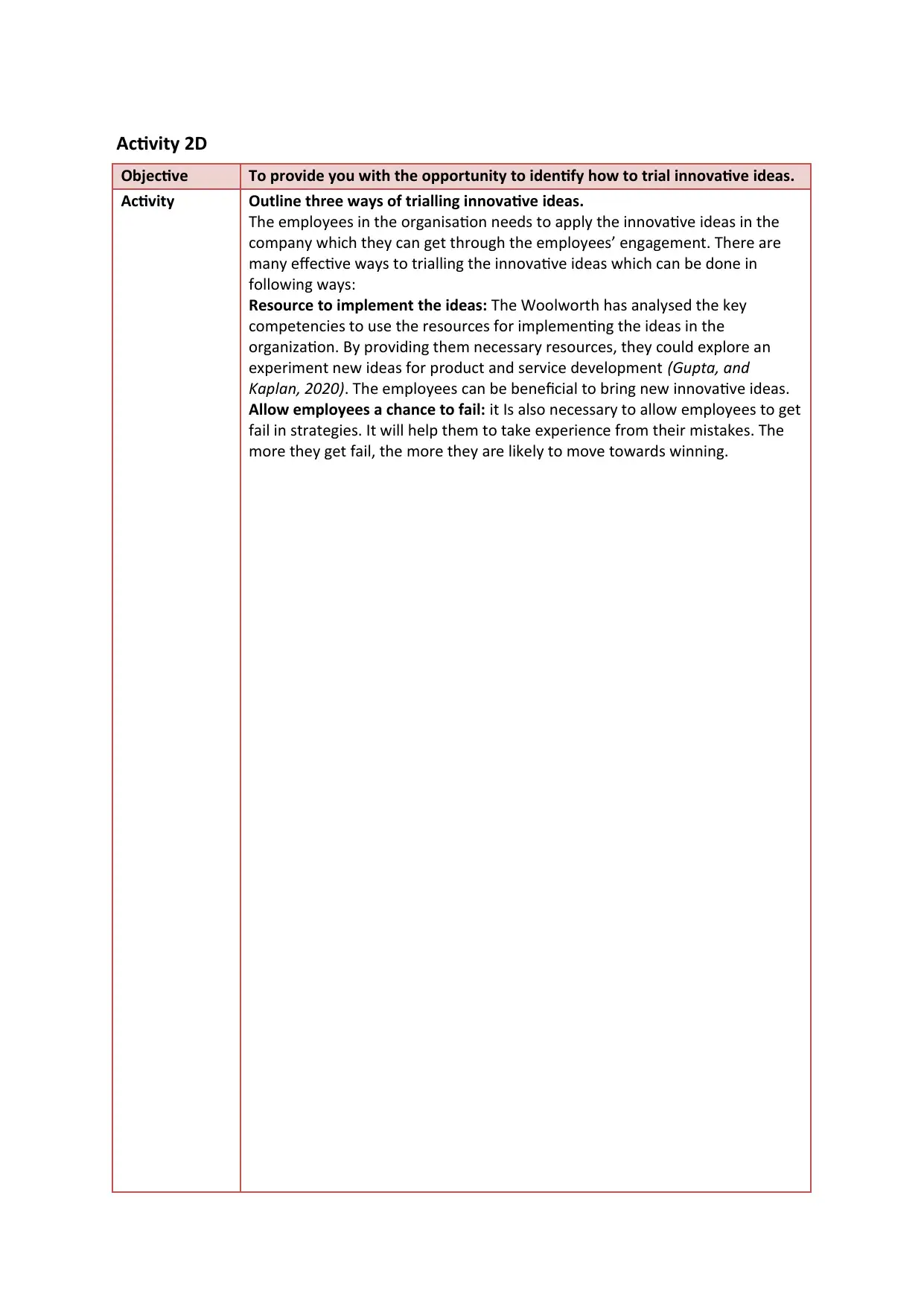
Activity 2D
Objective To provide you with the opportunity to identify how to trial innovative ideas.
Activity Outline three ways of trialling innovative ideas.
The employees in the organisation needs to apply the innovative ideas in the
company which they can get through the employees’ engagement. There are
many effective ways to trialling the innovative ideas which can be done in
following ways:
Resource to implement the ideas: The Woolworth has analysed the key
competencies to use the resources for implementing the ideas in the
organization. By providing them necessary resources, they could explore an
experiment new ideas for product and service development (Gupta, and
Kaplan, 2020). The employees can be beneficial to bring new innovative ideas.
Allow employees a chance to fail: it Is also necessary to allow employees to get
fail in strategies. It will help them to take experience from their mistakes. The
more they get fail, the more they are likely to move towards winning.
Objective To provide you with the opportunity to identify how to trial innovative ideas.
Activity Outline three ways of trialling innovative ideas.
The employees in the organisation needs to apply the innovative ideas in the
company which they can get through the employees’ engagement. There are
many effective ways to trialling the innovative ideas which can be done in
following ways:
Resource to implement the ideas: The Woolworth has analysed the key
competencies to use the resources for implementing the ideas in the
organization. By providing them necessary resources, they could explore an
experiment new ideas for product and service development (Gupta, and
Kaplan, 2020). The employees can be beneficial to bring new innovative ideas.
Allow employees a chance to fail: it Is also necessary to allow employees to get
fail in strategies. It will help them to take experience from their mistakes. The
more they get fail, the more they are likely to move towards winning.
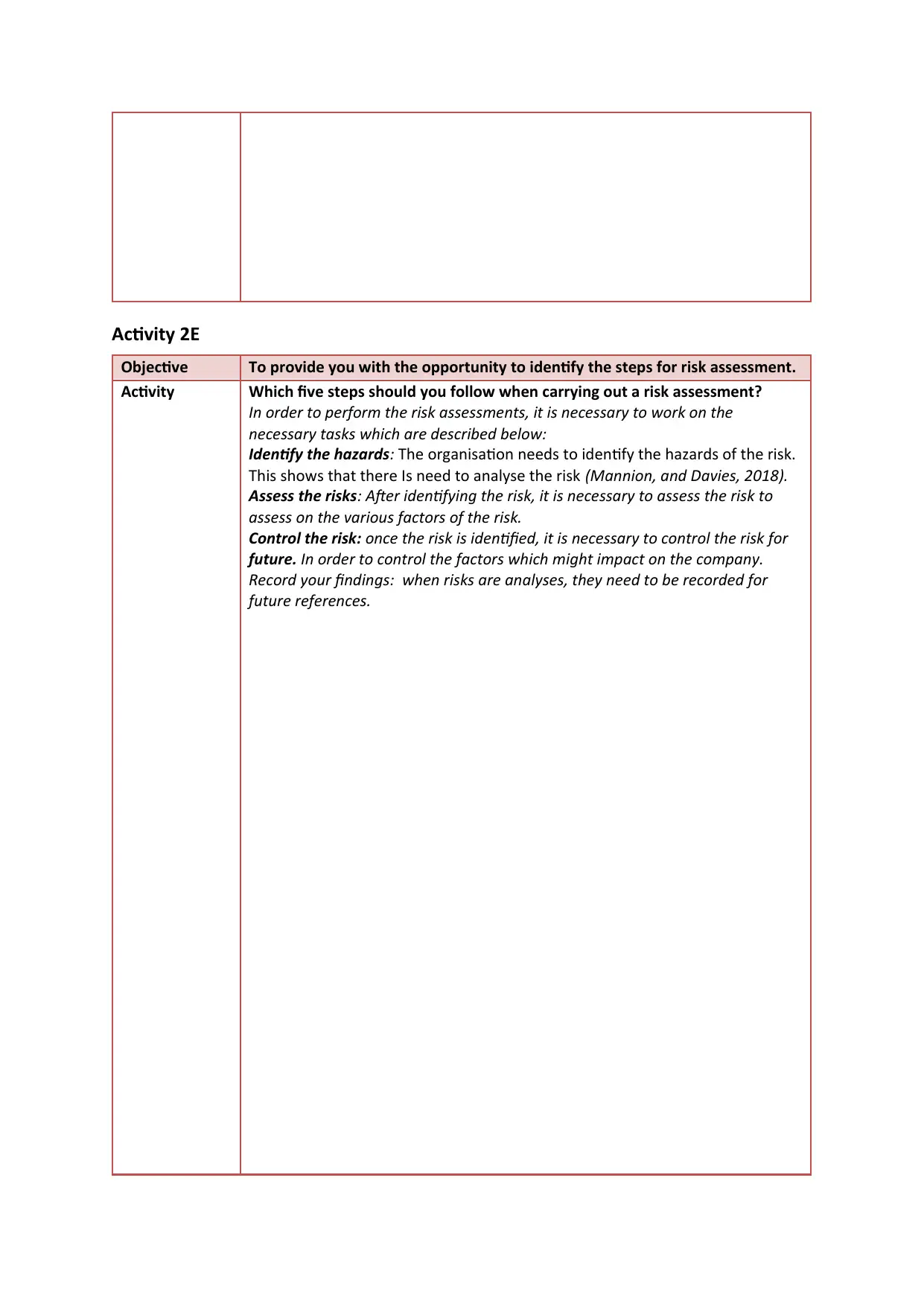
Activity 2E
Objective To provide you with the opportunity to identify the steps for risk assessment.
Activity Which five steps should you follow when carrying out a risk assessment?
In order to perform the risk assessments, it is necessary to work on the
necessary tasks which are described below:
Identify the hazards: The organisation needs to identify the hazards of the risk.
This shows that there Is need to analyse the risk (Mannion, and Davies, 2018).
Assess the risks: After identifying the risk, it is necessary to assess the risk to
assess on the various factors of the risk.
Control the risk: once the risk is identified, it is necessary to control the risk for
future. In order to control the factors which might impact on the company.
Record your findings: when risks are analyses, they need to be recorded for
future references.
Objective To provide you with the opportunity to identify the steps for risk assessment.
Activity Which five steps should you follow when carrying out a risk assessment?
In order to perform the risk assessments, it is necessary to work on the
necessary tasks which are described below:
Identify the hazards: The organisation needs to identify the hazards of the risk.
This shows that there Is need to analyse the risk (Mannion, and Davies, 2018).
Assess the risks: After identifying the risk, it is necessary to assess the risk to
assess on the various factors of the risk.
Control the risk: once the risk is identified, it is necessary to control the risk for
future. In order to control the factors which might impact on the company.
Record your findings: when risks are analyses, they need to be recorded for
future references.
Paraphrase This Document
Need a fresh take? Get an instant paraphrase of this document with our AI Paraphraser
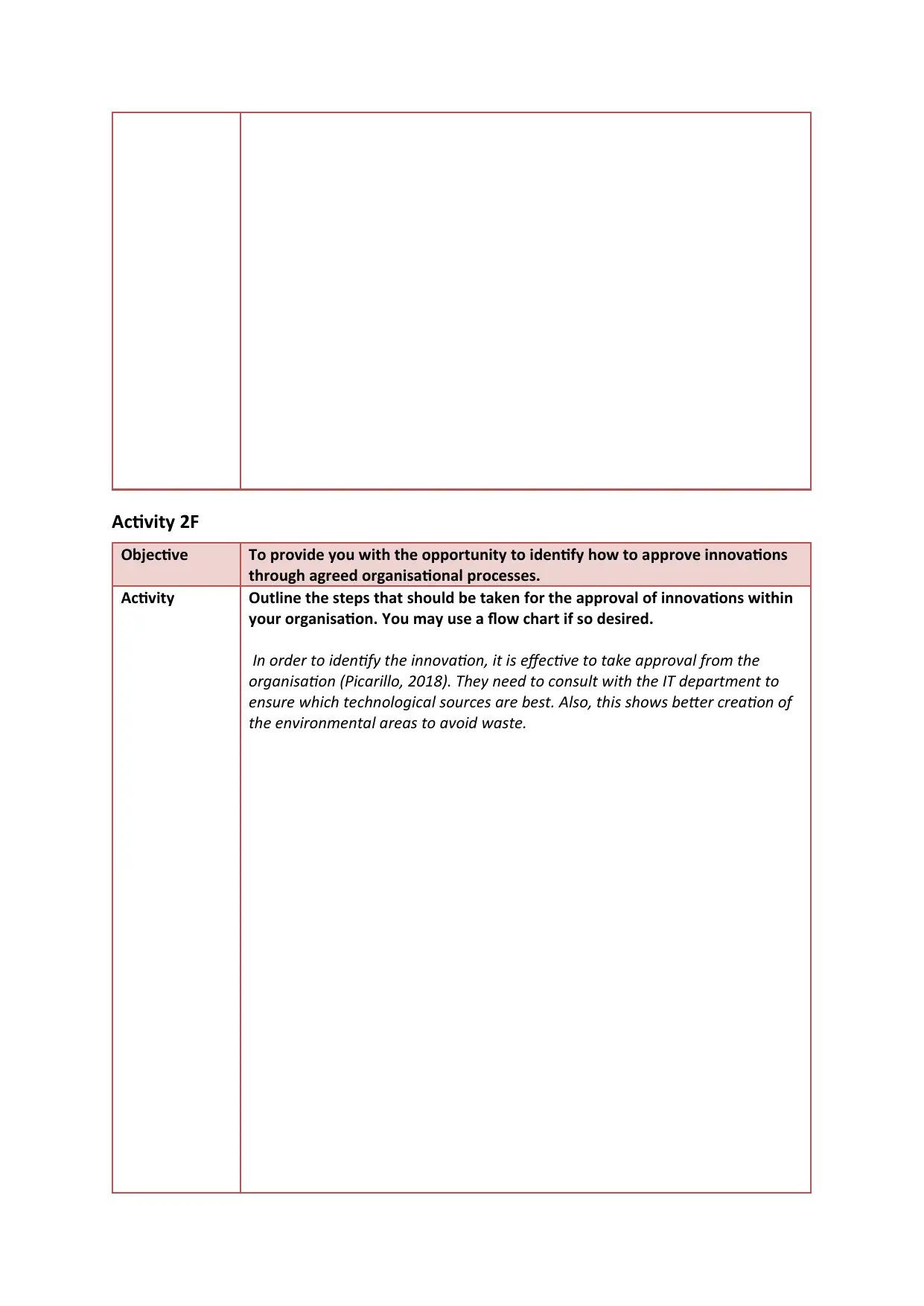
Activity 2F
Objective To provide you with the opportunity to identify how to approve innovations
through agreed organisational processes.
Activity Outline the steps that should be taken for the approval of innovations within
your organisation. You may use a flow chart if so desired.
In order to identify the innovation, it is effective to take approval from the
organisation (Picarillo, 2018). They need to consult with the IT department to
ensure which technological sources are best. Also, this shows better creation of
the environmental areas to avoid waste.
Objective To provide you with the opportunity to identify how to approve innovations
through agreed organisational processes.
Activity Outline the steps that should be taken for the approval of innovations within
your organisation. You may use a flow chart if so desired.
In order to identify the innovation, it is effective to take approval from the
organisation (Picarillo, 2018). They need to consult with the IT department to
ensure which technological sources are best. Also, this shows better creation of
the environmental areas to avoid waste.
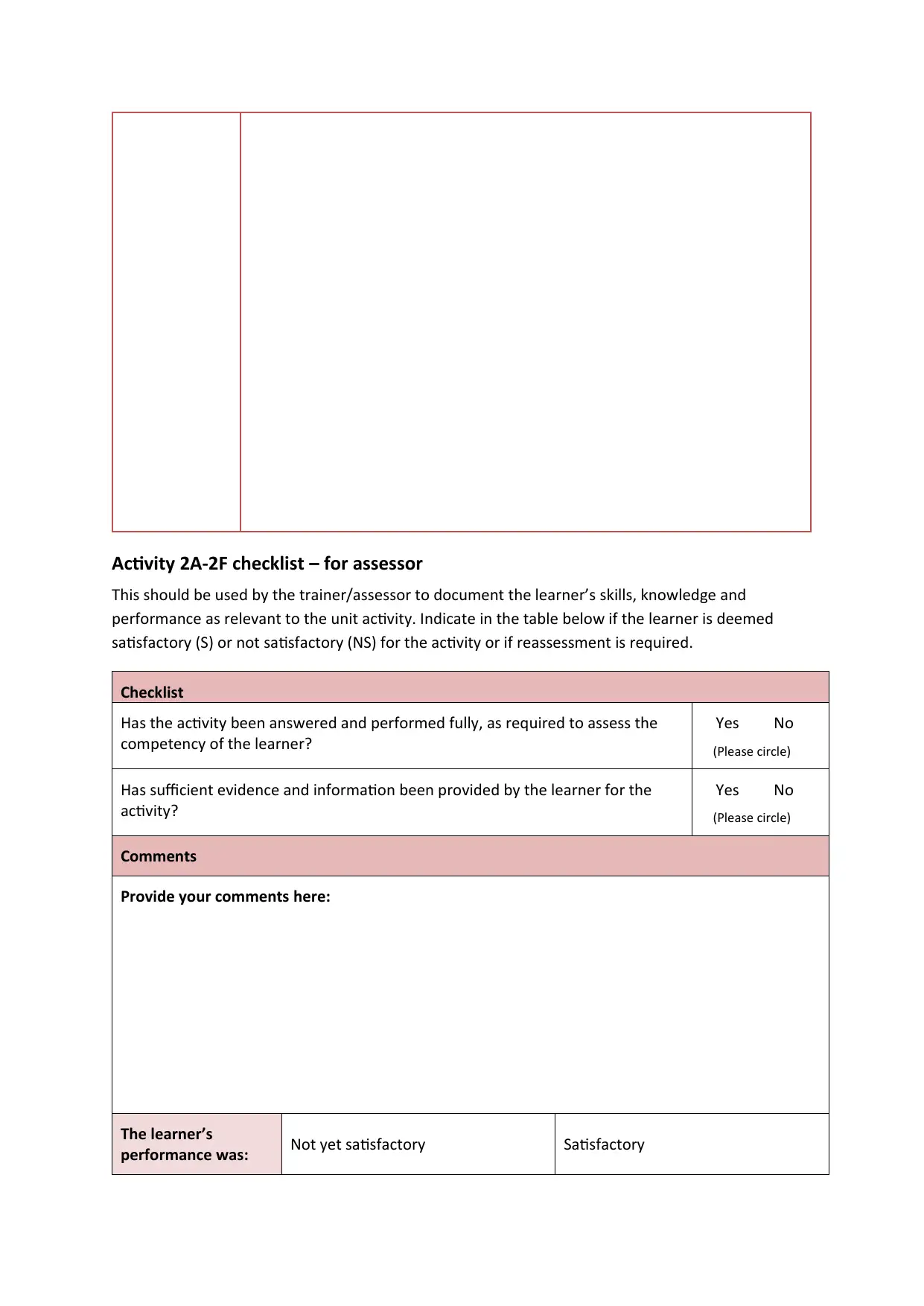
Activity 2A-2F checklist – for assessor
This should be used by the trainer/assessor to document the learner’s skills, knowledge and
performance as relevant to the unit activity. Indicate in the table below if the learner is deemed
satisfactory (S) or not satisfactory (NS) for the activity or if reassessment is required.
Checklist
Has the activity been answered and performed fully, as required to assess the
competency of the learner?
Yes No
(Please circle)
Has sufficient evidence and information been provided by the learner for the
activity?
Yes No
(Please circle)
Comments
Provide your comments here:
The learner’s
performance was: Not yet satisfactory Satisfactory
This should be used by the trainer/assessor to document the learner’s skills, knowledge and
performance as relevant to the unit activity. Indicate in the table below if the learner is deemed
satisfactory (S) or not satisfactory (NS) for the activity or if reassessment is required.
Checklist
Has the activity been answered and performed fully, as required to assess the
competency of the learner?
Yes No
(Please circle)
Has sufficient evidence and information been provided by the learner for the
activity?
Yes No
(Please circle)
Comments
Provide your comments here:
The learner’s
performance was: Not yet satisfactory Satisfactory
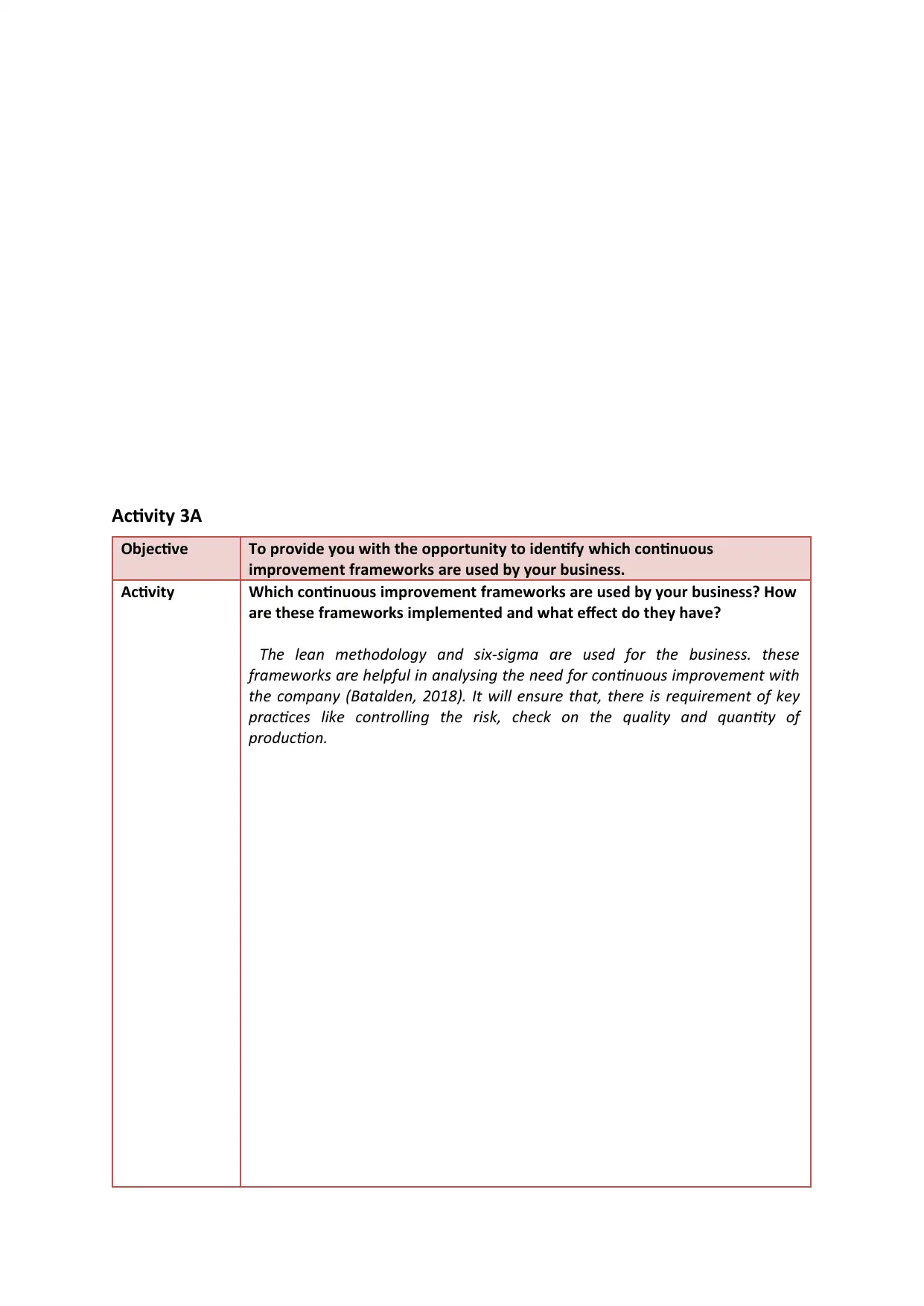
Activity 3A
Objective To provide you with the opportunity to identify which continuous
improvement frameworks are used by your business.
Activity Which continuous improvement frameworks are used by your business? How
are these frameworks implemented and what effect do they have?
The lean methodology and six-sigma are used for the business. these
frameworks are helpful in analysing the need for continuous improvement with
the company (Batalden, 2018). It will ensure that, there is requirement of key
practices like controlling the risk, check on the quality and quantity of
production.
Objective To provide you with the opportunity to identify which continuous
improvement frameworks are used by your business.
Activity Which continuous improvement frameworks are used by your business? How
are these frameworks implemented and what effect do they have?
The lean methodology and six-sigma are used for the business. these
frameworks are helpful in analysing the need for continuous improvement with
the company (Batalden, 2018). It will ensure that, there is requirement of key
practices like controlling the risk, check on the quality and quantity of
production.
Secure Best Marks with AI Grader
Need help grading? Try our AI Grader for instant feedback on your assignments.

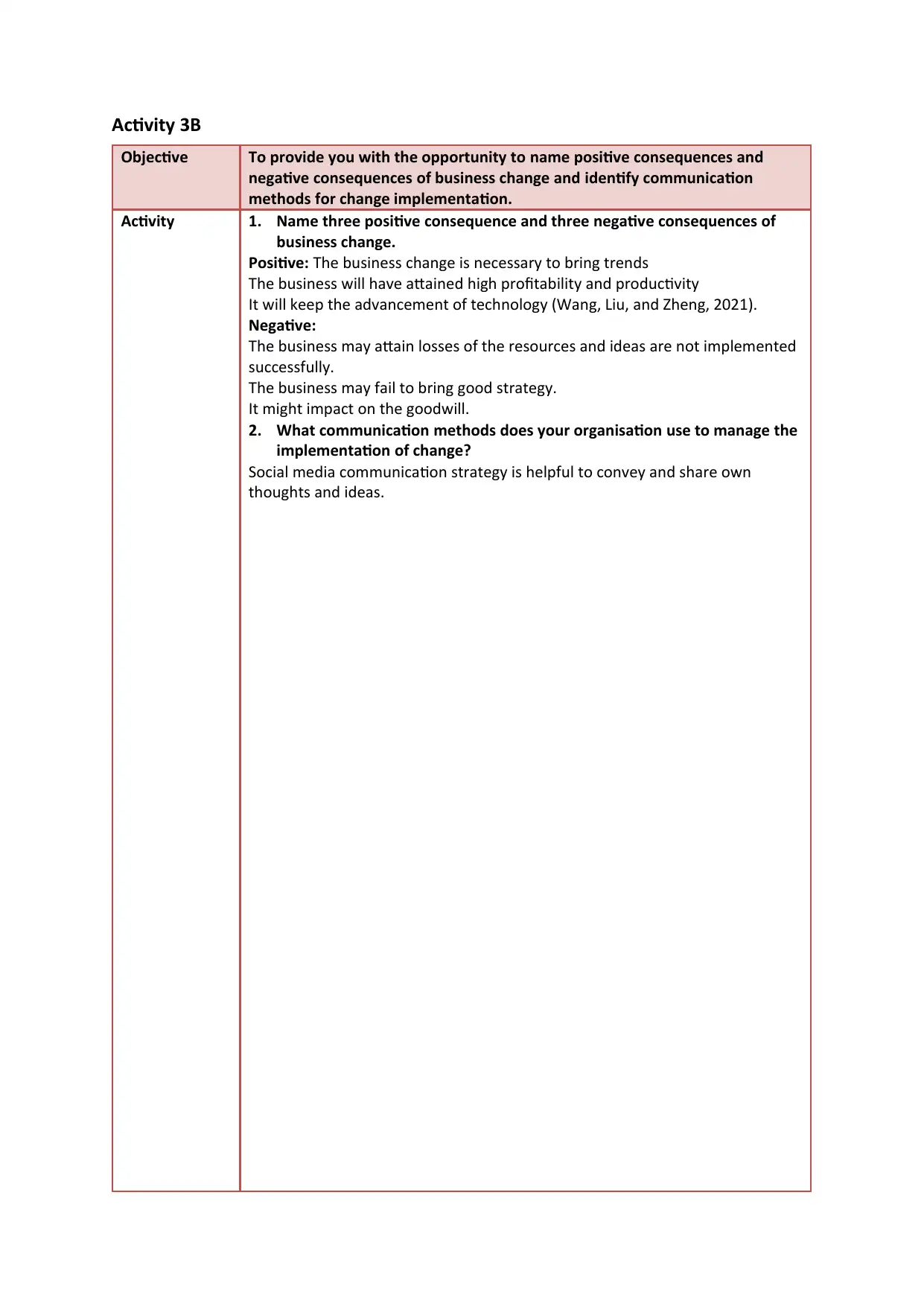
Activity 3B
Objective To provide you with the opportunity to name positive consequences and
negative consequences of business change and identify communication
methods for change implementation.
Activity 1. Name three positive consequence and three negative consequences of
business change.
Positive: The business change is necessary to bring trends
The business will have attained high profitability and productivity
It will keep the advancement of technology (Wang, Liu, and Zheng, 2021).
Negative:
The business may attain losses of the resources and ideas are not implemented
successfully.
The business may fail to bring good strategy.
It might impact on the goodwill.
2. What communication methods does your organisation use to manage the
implementation of change?
Social media communication strategy is helpful to convey and share own
thoughts and ideas.
Objective To provide you with the opportunity to name positive consequences and
negative consequences of business change and identify communication
methods for change implementation.
Activity 1. Name three positive consequence and three negative consequences of
business change.
Positive: The business change is necessary to bring trends
The business will have attained high profitability and productivity
It will keep the advancement of technology (Wang, Liu, and Zheng, 2021).
Negative:
The business may attain losses of the resources and ideas are not implemented
successfully.
The business may fail to bring good strategy.
It might impact on the goodwill.
2. What communication methods does your organisation use to manage the
implementation of change?
Social media communication strategy is helpful to convey and share own
thoughts and ideas.

Activity 3C
Objective To provide you with the opportunity to complete a contingency plan template.
Activity Apply the following contingency plan template to a negative event which may
impact your business.
Type of
event
Likelihood Potential
impact
Appropriate
response
Staff
members
involved
Resources
required
Losses of
resources
Low
High In order to
save the
resources,
the
Woolworth
need to make
appropriate
strategies for
resource
management
through
inventory
management
practices.
The
human
resource
managers
and
operation
team is
involved
to manage
the
resources.
Digital
software
to check
inventory
usage.
Objective To provide you with the opportunity to complete a contingency plan template.
Activity Apply the following contingency plan template to a negative event which may
impact your business.
Type of
event
Likelihood Potential
impact
Appropriate
response
Staff
members
involved
Resources
required
Losses of
resources
Low
High In order to
save the
resources,
the
Woolworth
need to make
appropriate
strategies for
resource
management
through
inventory
management
practices.
The
human
resource
managers
and
operation
team is
involved
to manage
the
resources.
Digital
software
to check
inventory
usage.
Paraphrase This Document
Need a fresh take? Get an instant paraphrase of this document with our AI Paraphraser
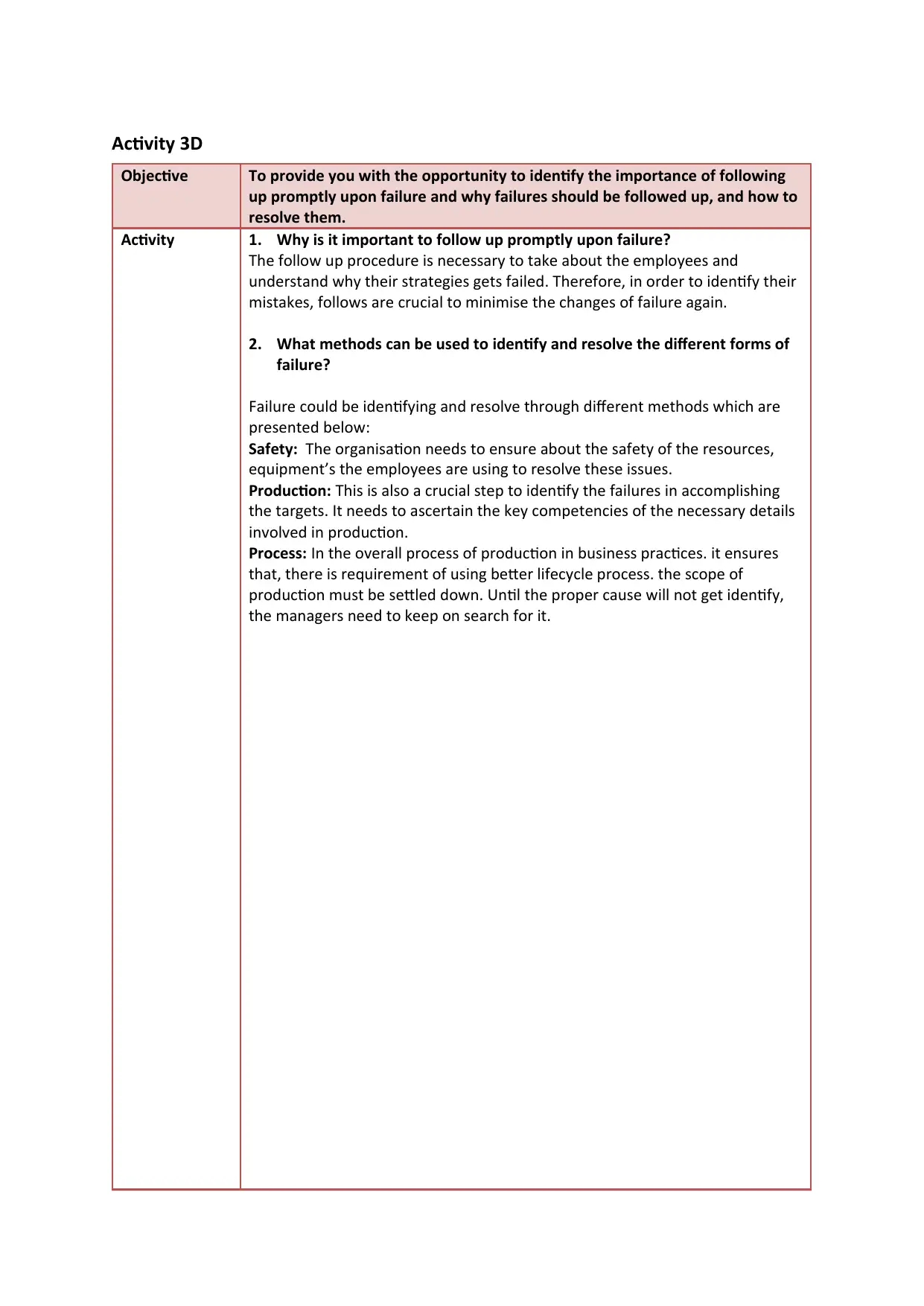
Activity 3D
Objective To provide you with the opportunity to identify the importance of following
up promptly upon failure and why failures should be followed up, and how to
resolve them.
Activity 1. Why is it important to follow up promptly upon failure?
The follow up procedure is necessary to take about the employees and
understand why their strategies gets failed. Therefore, in order to identify their
mistakes, follows are crucial to minimise the changes of failure again.
2. What methods can be used to identify and resolve the different forms of
failure?
Failure could be identifying and resolve through different methods which are
presented below:
Safety: The organisation needs to ensure about the safety of the resources,
equipment’s the employees are using to resolve these issues.
Production: This is also a crucial step to identify the failures in accomplishing
the targets. It needs to ascertain the key competencies of the necessary details
involved in production.
Process: In the overall process of production in business practices. it ensures
that, there is requirement of using better lifecycle process. the scope of
production must be settled down. Until the proper cause will not get identify,
the managers need to keep on search for it.
Objective To provide you with the opportunity to identify the importance of following
up promptly upon failure and why failures should be followed up, and how to
resolve them.
Activity 1. Why is it important to follow up promptly upon failure?
The follow up procedure is necessary to take about the employees and
understand why their strategies gets failed. Therefore, in order to identify their
mistakes, follows are crucial to minimise the changes of failure again.
2. What methods can be used to identify and resolve the different forms of
failure?
Failure could be identifying and resolve through different methods which are
presented below:
Safety: The organisation needs to ensure about the safety of the resources,
equipment’s the employees are using to resolve these issues.
Production: This is also a crucial step to identify the failures in accomplishing
the targets. It needs to ascertain the key competencies of the necessary details
involved in production.
Process: In the overall process of production in business practices. it ensures
that, there is requirement of using better lifecycle process. the scope of
production must be settled down. Until the proper cause will not get identify,
the managers need to keep on search for it.
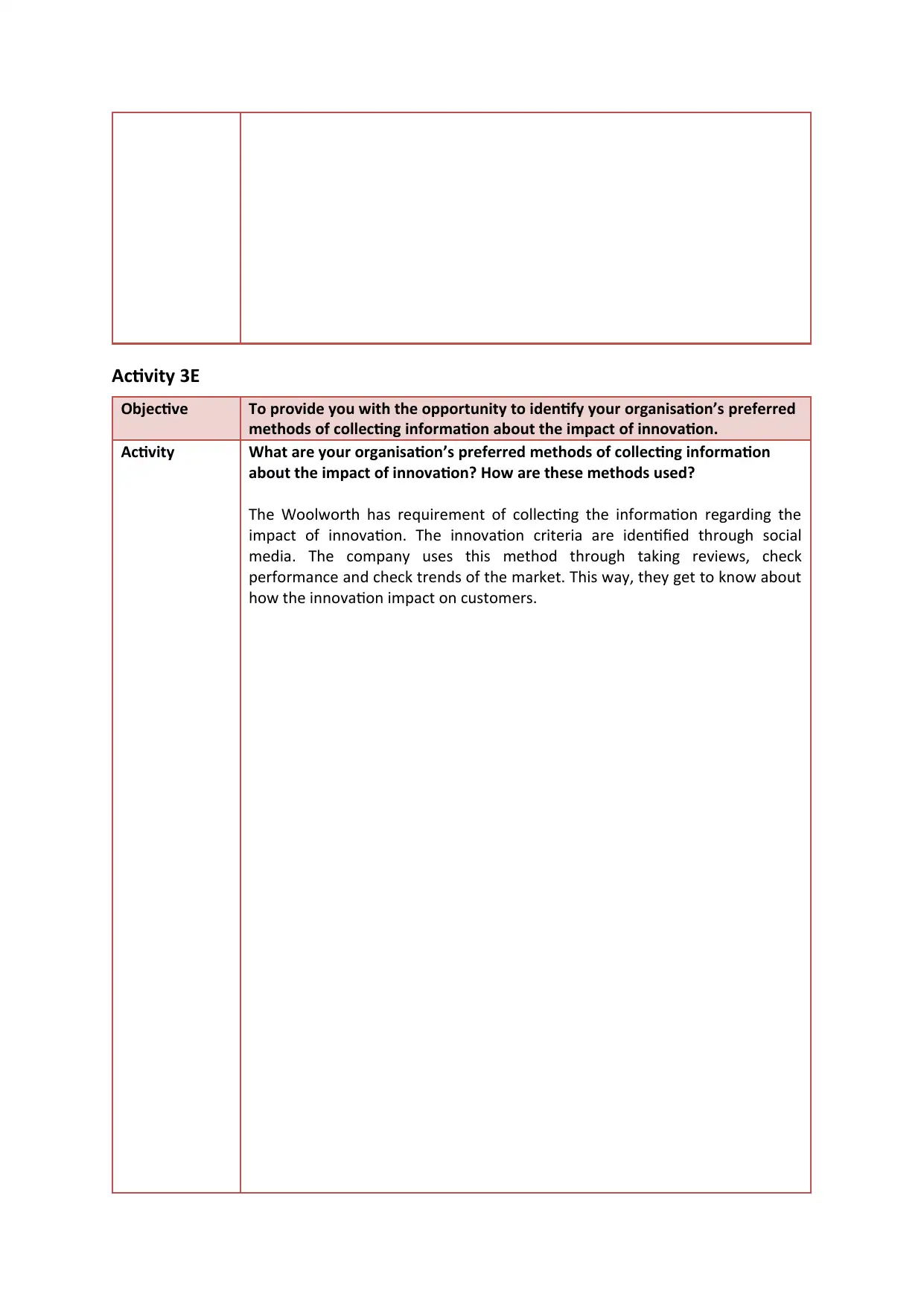
Activity 3E
Objective To provide you with the opportunity to identify your organisation’s preferred
methods of collecting information about the impact of innovation.
Activity What are your organisation’s preferred methods of collecting information
about the impact of innovation? How are these methods used?
The Woolworth has requirement of collecting the information regarding the
impact of innovation. The innovation criteria are identified through social
media. The company uses this method through taking reviews, check
performance and check trends of the market. This way, they get to know about
how the innovation impact on customers.
Objective To provide you with the opportunity to identify your organisation’s preferred
methods of collecting information about the impact of innovation.
Activity What are your organisation’s preferred methods of collecting information
about the impact of innovation? How are these methods used?
The Woolworth has requirement of collecting the information regarding the
impact of innovation. The innovation criteria are identified through social
media. The company uses this method through taking reviews, check
performance and check trends of the market. This way, they get to know about
how the innovation impact on customers.
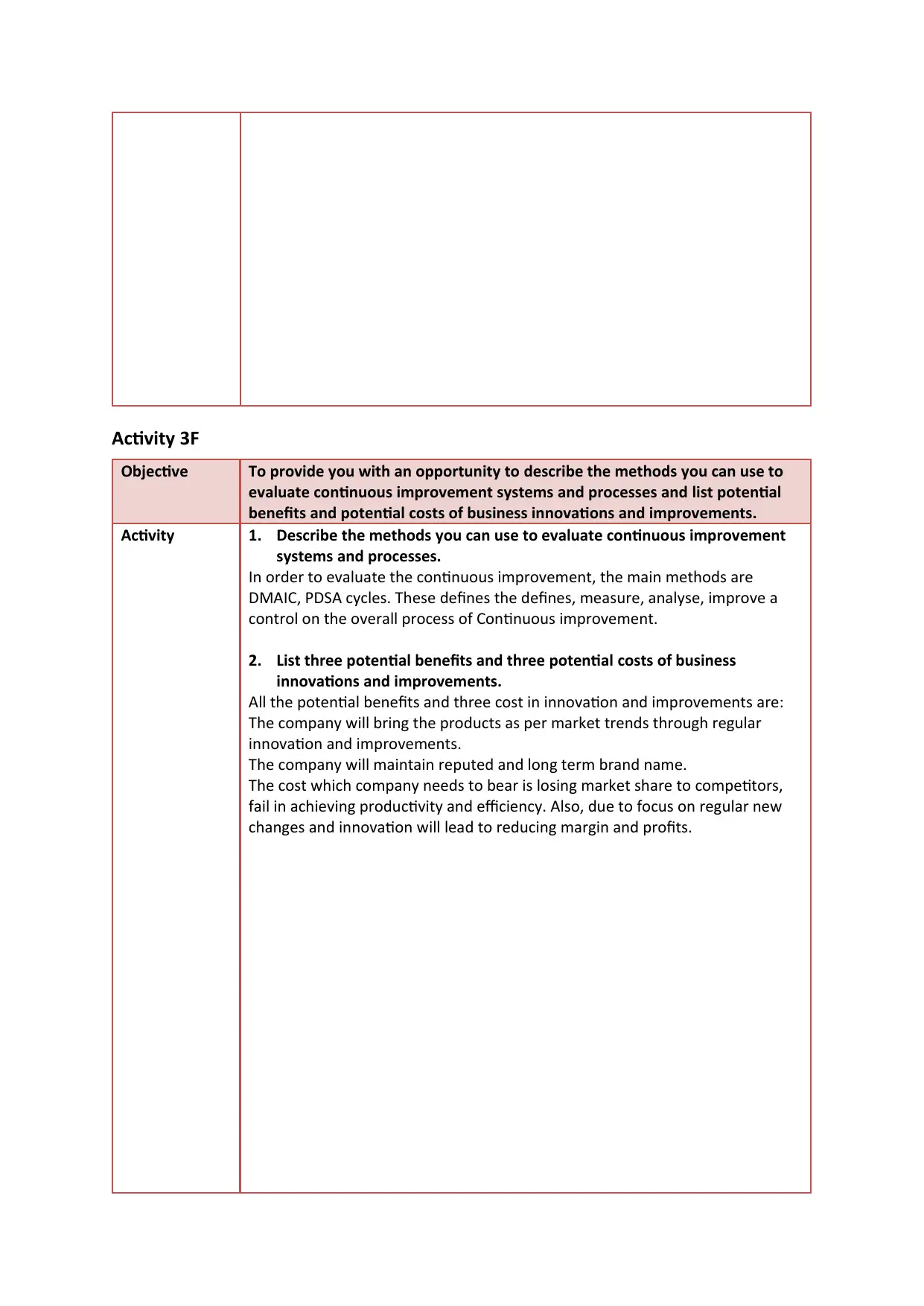
Activity 3F
Objective To provide you with an opportunity to describe the methods you can use to
evaluate continuous improvement systems and processes and list potential
benefits and potential costs of business innovations and improvements.
Activity 1. Describe the methods you can use to evaluate continuous improvement
systems and processes.
In order to evaluate the continuous improvement, the main methods are
DMAIC, PDSA cycles. These defines the defines, measure, analyse, improve a
control on the overall process of Continuous improvement.
2. List three potential benefits and three potential costs of business
innovations and improvements.
All the potential benefits and three cost in innovation and improvements are:
The company will bring the products as per market trends through regular
innovation and improvements.
The company will maintain reputed and long term brand name.
The cost which company needs to bear is losing market share to competitors,
fail in achieving productivity and efficiency. Also, due to focus on regular new
changes and innovation will lead to reducing margin and profits.
Objective To provide you with an opportunity to describe the methods you can use to
evaluate continuous improvement systems and processes and list potential
benefits and potential costs of business innovations and improvements.
Activity 1. Describe the methods you can use to evaluate continuous improvement
systems and processes.
In order to evaluate the continuous improvement, the main methods are
DMAIC, PDSA cycles. These defines the defines, measure, analyse, improve a
control on the overall process of Continuous improvement.
2. List three potential benefits and three potential costs of business
innovations and improvements.
All the potential benefits and three cost in innovation and improvements are:
The company will bring the products as per market trends through regular
innovation and improvements.
The company will maintain reputed and long term brand name.
The cost which company needs to bear is losing market share to competitors,
fail in achieving productivity and efficiency. Also, due to focus on regular new
changes and innovation will lead to reducing margin and profits.
Secure Best Marks with AI Grader
Need help grading? Try our AI Grader for instant feedback on your assignments.
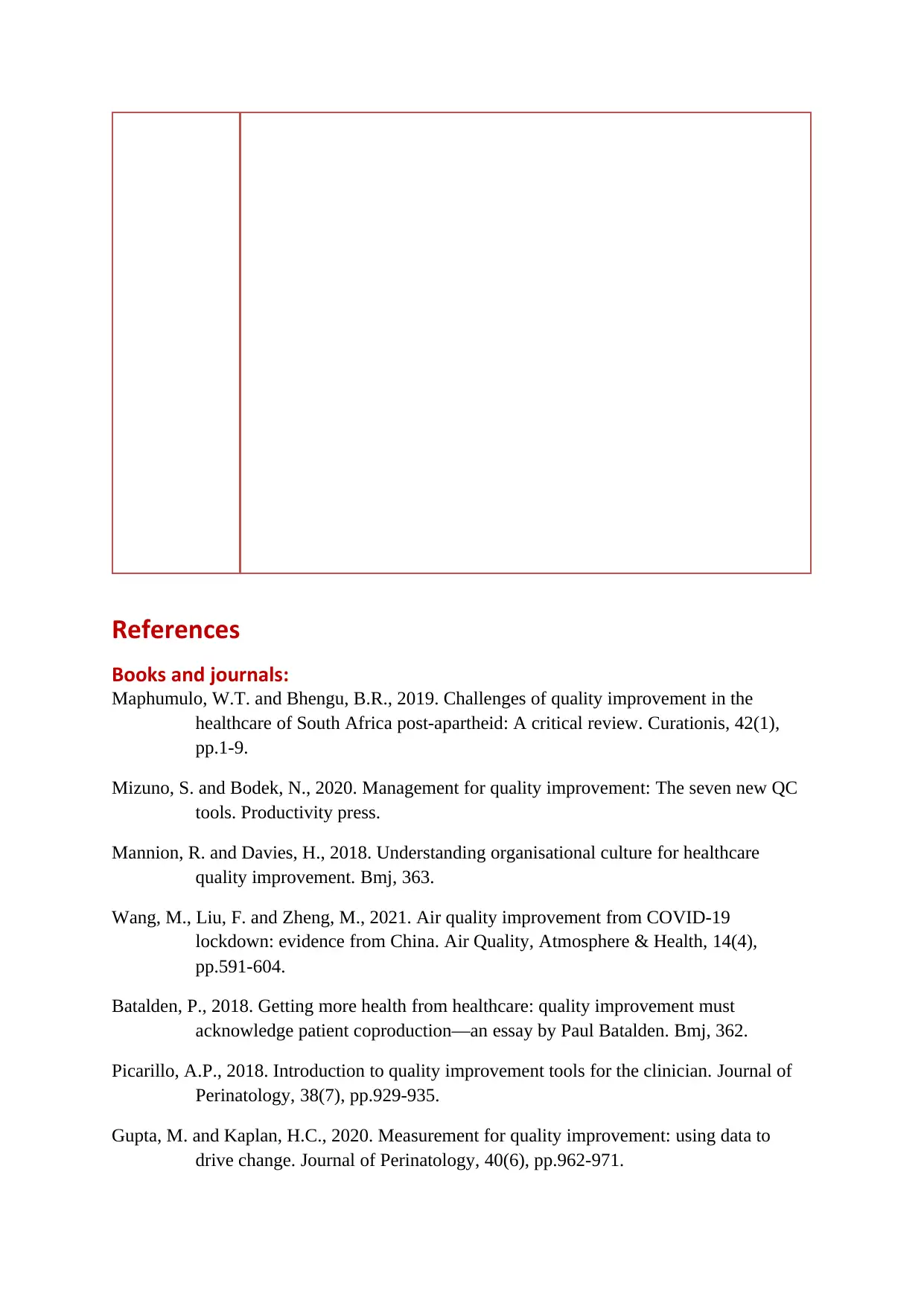
References
Books and journals:
Maphumulo, W.T. and Bhengu, B.R., 2019. Challenges of quality improvement in the
healthcare of South Africa post-apartheid: A critical review. Curationis, 42(1),
pp.1-9.
Mizuno, S. and Bodek, N., 2020. Management for quality improvement: The seven new QC
tools. Productivity press.
Mannion, R. and Davies, H., 2018. Understanding organisational culture for healthcare
quality improvement. Bmj, 363.
Wang, M., Liu, F. and Zheng, M., 2021. Air quality improvement from COVID-19
lockdown: evidence from China. Air Quality, Atmosphere & Health, 14(4),
pp.591-604.
Batalden, P., 2018. Getting more health from healthcare: quality improvement must
acknowledge patient coproduction—an essay by Paul Batalden. Bmj, 362.
Picarillo, A.P., 2018. Introduction to quality improvement tools for the clinician. Journal of
Perinatology, 38(7), pp.929-935.
Gupta, M. and Kaplan, H.C., 2020. Measurement for quality improvement: using data to
drive change. Journal of Perinatology, 40(6), pp.962-971.
Books and journals:
Maphumulo, W.T. and Bhengu, B.R., 2019. Challenges of quality improvement in the
healthcare of South Africa post-apartheid: A critical review. Curationis, 42(1),
pp.1-9.
Mizuno, S. and Bodek, N., 2020. Management for quality improvement: The seven new QC
tools. Productivity press.
Mannion, R. and Davies, H., 2018. Understanding organisational culture for healthcare
quality improvement. Bmj, 363.
Wang, M., Liu, F. and Zheng, M., 2021. Air quality improvement from COVID-19
lockdown: evidence from China. Air Quality, Atmosphere & Health, 14(4),
pp.591-604.
Batalden, P., 2018. Getting more health from healthcare: quality improvement must
acknowledge patient coproduction—an essay by Paul Batalden. Bmj, 362.
Picarillo, A.P., 2018. Introduction to quality improvement tools for the clinician. Journal of
Perinatology, 38(7), pp.929-935.
Gupta, M. and Kaplan, H.C., 2020. Measurement for quality improvement: using data to
drive change. Journal of Perinatology, 40(6), pp.962-971.
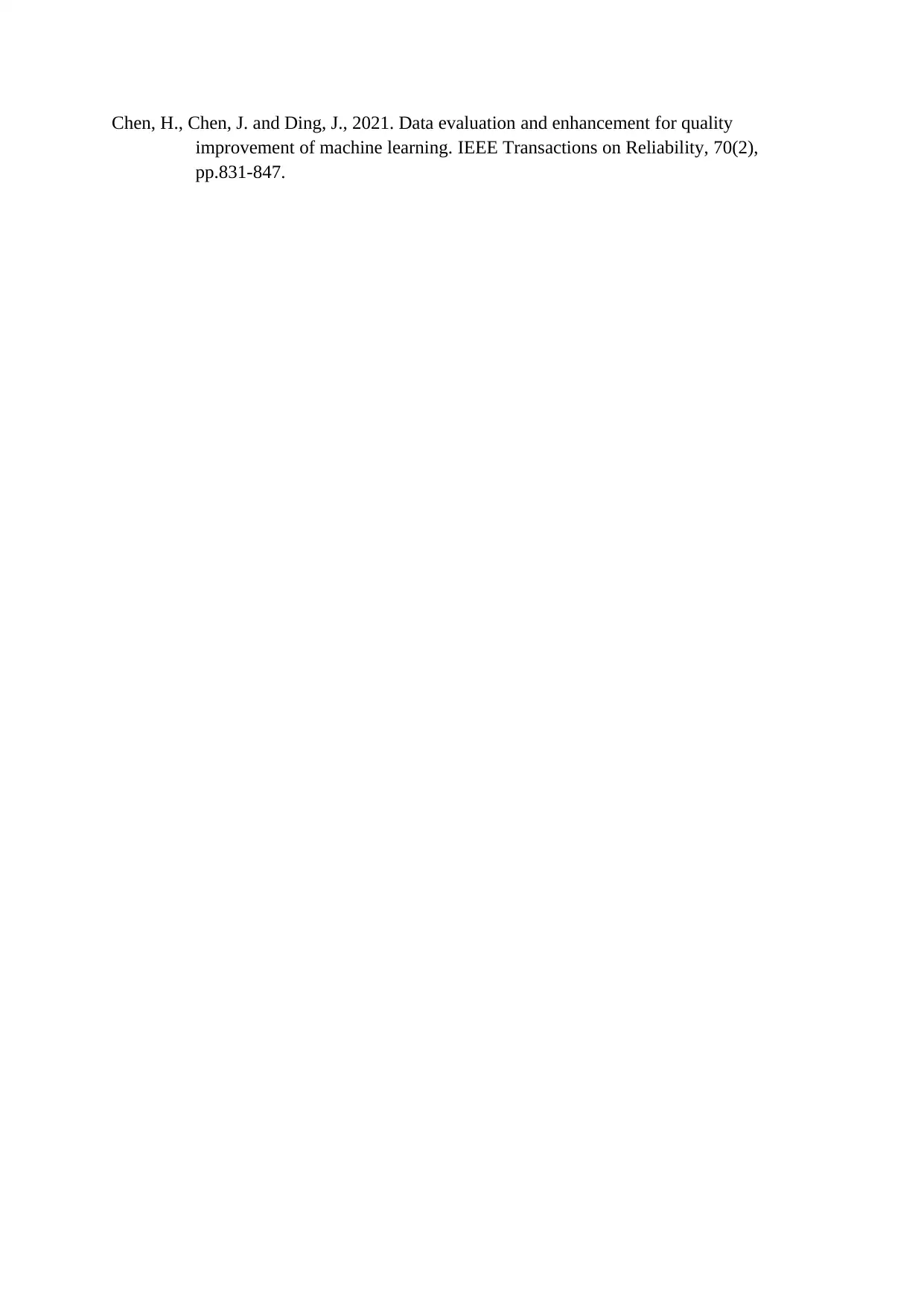
Chen, H., Chen, J. and Ding, J., 2021. Data evaluation and enhancement for quality
improvement of machine learning. IEEE Transactions on Reliability, 70(2),
pp.831-847.
improvement of machine learning. IEEE Transactions on Reliability, 70(2),
pp.831-847.
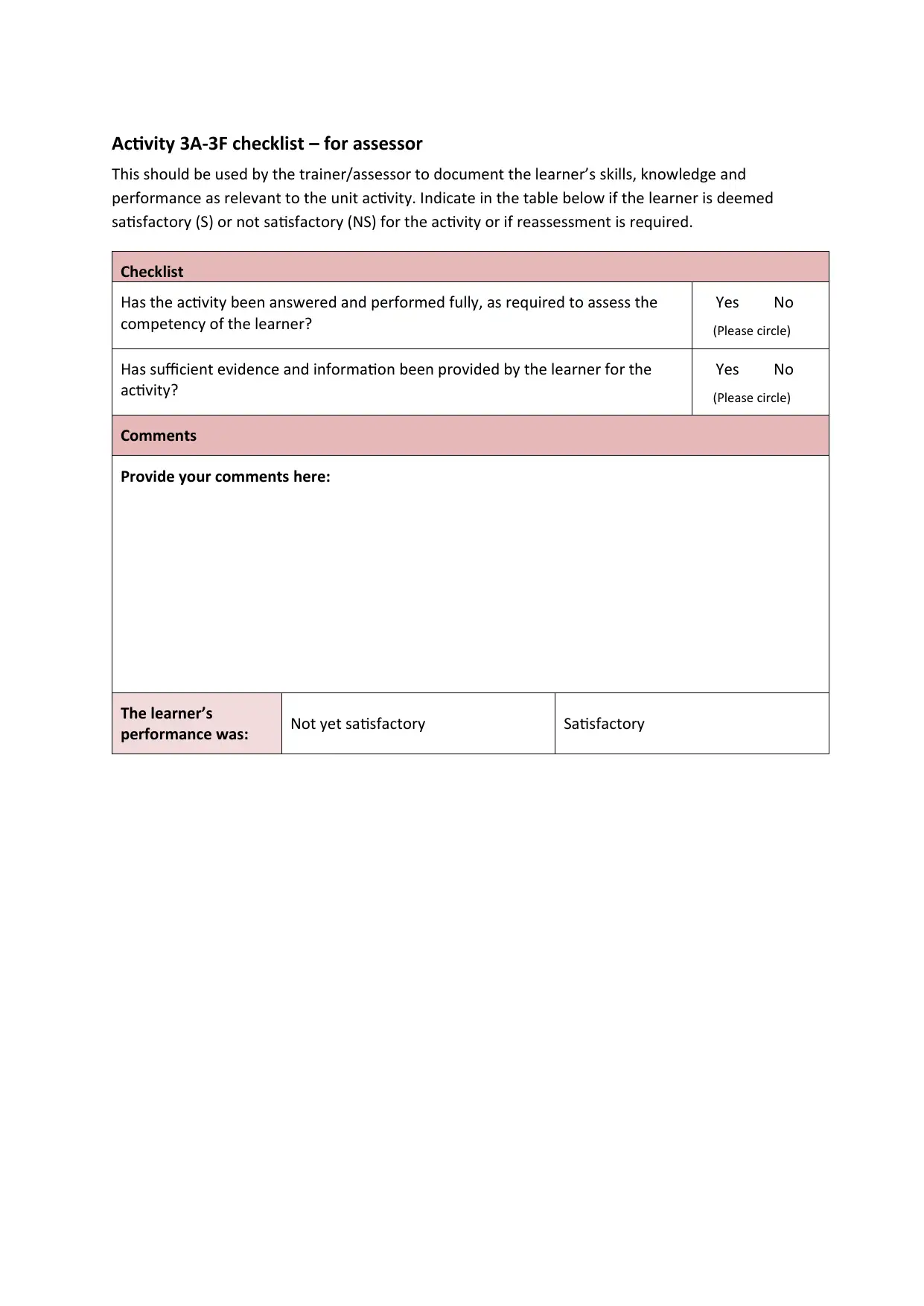
Activity 3A-3F checklist – for assessor
This should be used by the trainer/assessor to document the learner’s skills, knowledge and
performance as relevant to the unit activity. Indicate in the table below if the learner is deemed
satisfactory (S) or not satisfactory (NS) for the activity or if reassessment is required.
Checklist
Has the activity been answered and performed fully, as required to assess the
competency of the learner?
Yes No
(Please circle)
Has sufficient evidence and information been provided by the learner for the
activity?
Yes No
(Please circle)
Comments
Provide your comments here:
The learner’s
performance was: Not yet satisfactory Satisfactory
This should be used by the trainer/assessor to document the learner’s skills, knowledge and
performance as relevant to the unit activity. Indicate in the table below if the learner is deemed
satisfactory (S) or not satisfactory (NS) for the activity or if reassessment is required.
Checklist
Has the activity been answered and performed fully, as required to assess the
competency of the learner?
Yes No
(Please circle)
Has sufficient evidence and information been provided by the learner for the
activity?
Yes No
(Please circle)
Comments
Provide your comments here:
The learner’s
performance was: Not yet satisfactory Satisfactory
Paraphrase This Document
Need a fresh take? Get an instant paraphrase of this document with our AI Paraphraser
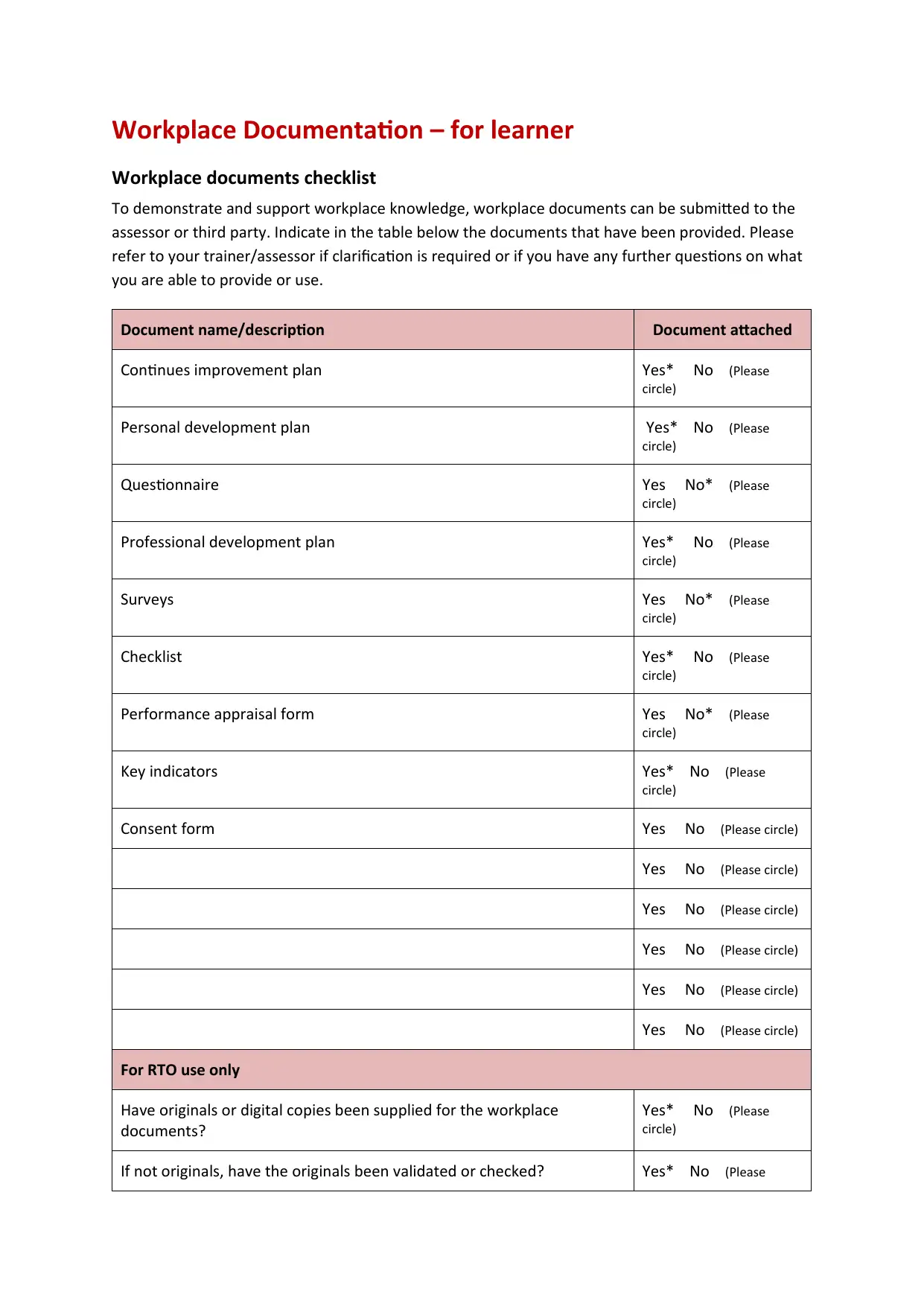
Workplace Documentation – for learner
Workplace documents checklist
To demonstrate and support workplace knowledge, workplace documents can be submitted to the
assessor or third party. Indicate in the table below the documents that have been provided. Please
refer to your trainer/assessor if clarification is required or if you have any further questions on what
you are able to provide or use.
Document name/description Document attached
Continues improvement plan Yes* No (Please
circle)
Personal development plan Yes* No (Please
circle)
Questionnaire Yes No* (Please
circle)
Professional development plan Yes* No (Please
circle)
Surveys Yes No* (Please
circle)
Checklist Yes* No (Please
circle)
Performance appraisal form Yes No* (Please
circle)
Key indicators Yes* No (Please
circle)
Consent form Yes No (Please circle)
Yes No (Please circle)
Yes No (Please circle)
Yes No (Please circle)
Yes No (Please circle)
Yes No (Please circle)
For RTO use only
Have originals or digital copies been supplied for the workplace
documents?
Yes* No (Please
circle)
If not originals, have the originals been validated or checked? Yes* No (Please
Workplace documents checklist
To demonstrate and support workplace knowledge, workplace documents can be submitted to the
assessor or third party. Indicate in the table below the documents that have been provided. Please
refer to your trainer/assessor if clarification is required or if you have any further questions on what
you are able to provide or use.
Document name/description Document attached
Continues improvement plan Yes* No (Please
circle)
Personal development plan Yes* No (Please
circle)
Questionnaire Yes No* (Please
circle)
Professional development plan Yes* No (Please
circle)
Surveys Yes No* (Please
circle)
Checklist Yes* No (Please
circle)
Performance appraisal form Yes No* (Please
circle)
Key indicators Yes* No (Please
circle)
Consent form Yes No (Please circle)
Yes No (Please circle)
Yes No (Please circle)
Yes No (Please circle)
Yes No (Please circle)
Yes No (Please circle)
For RTO use only
Have originals or digital copies been supplied for the workplace
documents?
Yes* No (Please
circle)
If not originals, have the originals been validated or checked? Yes* No (Please
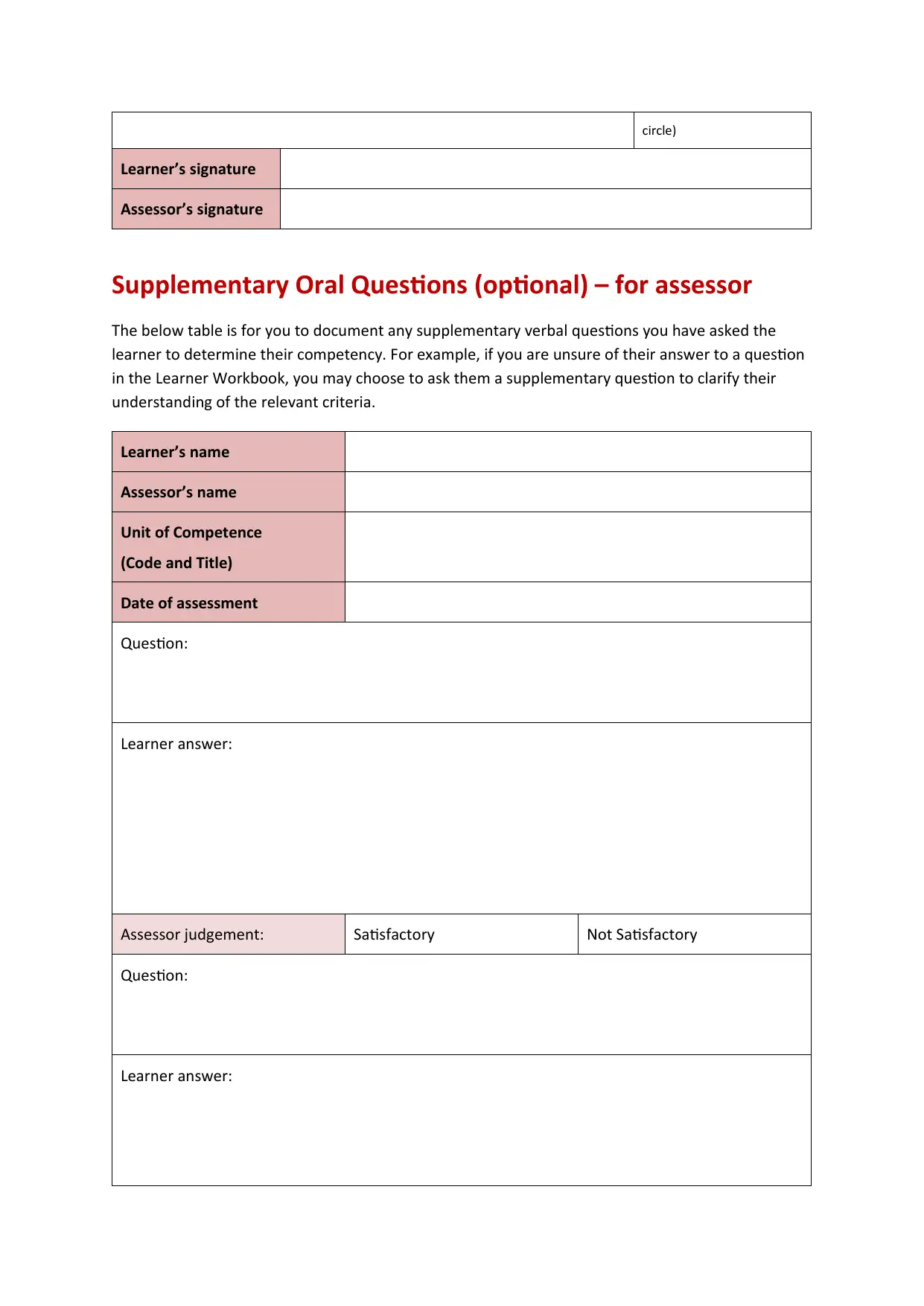
circle)
Learner’s signature
Assessor’s signature
Supplementary Oral Questions (optional) – for assessor
The below table is for you to document any supplementary verbal questions you have asked the
learner to determine their competency. For example, if you are unsure of their answer to a question
in the Learner Workbook, you may choose to ask them a supplementary question to clarify their
understanding of the relevant criteria.
Learner’s name
Assessor’s name
Unit of Competence
(Code and Title)
Date of assessment
Question:
Learner answer:
Assessor judgement: Satisfactory Not Satisfactory
Question:
Learner answer:
Learner’s signature
Assessor’s signature
Supplementary Oral Questions (optional) – for assessor
The below table is for you to document any supplementary verbal questions you have asked the
learner to determine their competency. For example, if you are unsure of their answer to a question
in the Learner Workbook, you may choose to ask them a supplementary question to clarify their
understanding of the relevant criteria.
Learner’s name
Assessor’s name
Unit of Competence
(Code and Title)
Date of assessment
Question:
Learner answer:
Assessor judgement: Satisfactory Not Satisfactory
Question:
Learner answer:

Assessor judgement: Satisfactory Not Satisfactory
Secure Best Marks with AI Grader
Need help grading? Try our AI Grader for instant feedback on your assignments.

Question:
Learner answer:
Assessor judgement: Satisfactory Not Satisfactory
Question:
Learner answer:
Assessor judgement: Satisfactory Not Satisfactory
Question:
Learner answer:
Assessor judgement: Satisfactory Not Satisfactory
Learner answer:
Assessor judgement: Satisfactory Not Satisfactory
Question:
Learner answer:
Assessor judgement: Satisfactory Not Satisfactory
Question:
Learner answer:
Assessor judgement: Satisfactory Not Satisfactory

Feedback for the learner
I have read, understood, and am satisfied with the feedback provided by the assessor.
Learner’s name
Learner’s signature
Assessor’s name
Assessor’s signature
I have read, understood, and am satisfied with the feedback provided by the assessor.
Learner’s name
Learner’s signature
Assessor’s name
Assessor’s signature
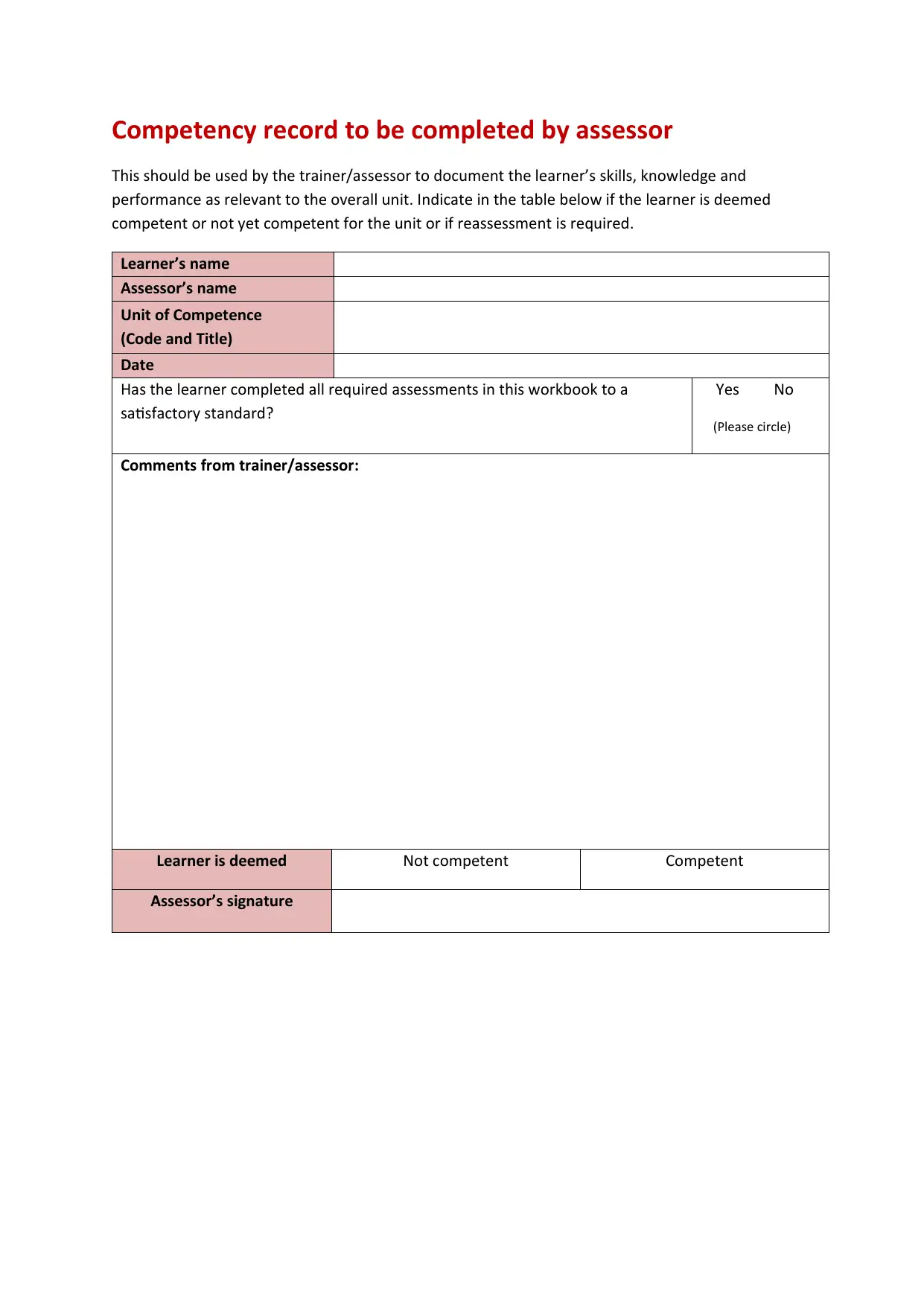
Competency record to be completed by assessor
This should be used by the trainer/assessor to document the learner’s skills, knowledge and
performance as relevant to the overall unit. Indicate in the table below if the learner is deemed
competent or not yet competent for the unit or if reassessment is required.
Learner’s name
Assessor’s name
Unit of Competence
(Code and Title)
Date
Has the learner completed all required assessments in this workbook to a
satisfactory standard?
Yes No
(Please circle)
Comments from trainer/assessor:
Learner is deemed Not competent Competent
Assessor’s signature
This should be used by the trainer/assessor to document the learner’s skills, knowledge and
performance as relevant to the overall unit. Indicate in the table below if the learner is deemed
competent or not yet competent for the unit or if reassessment is required.
Learner’s name
Assessor’s name
Unit of Competence
(Code and Title)
Date
Has the learner completed all required assessments in this workbook to a
satisfactory standard?
Yes No
(Please circle)
Comments from trainer/assessor:
Learner is deemed Not competent Competent
Assessor’s signature
1 out of 43
Related Documents
Your All-in-One AI-Powered Toolkit for Academic Success.
+13062052269
info@desklib.com
Available 24*7 on WhatsApp / Email
![[object Object]](/_next/static/media/star-bottom.7253800d.svg)
Unlock your academic potential
© 2024 | Zucol Services PVT LTD | All rights reserved.





